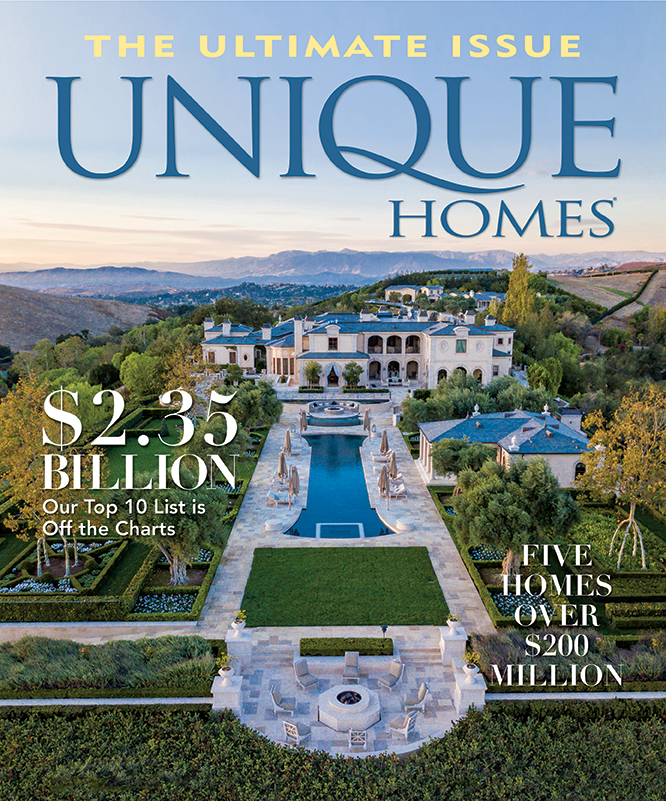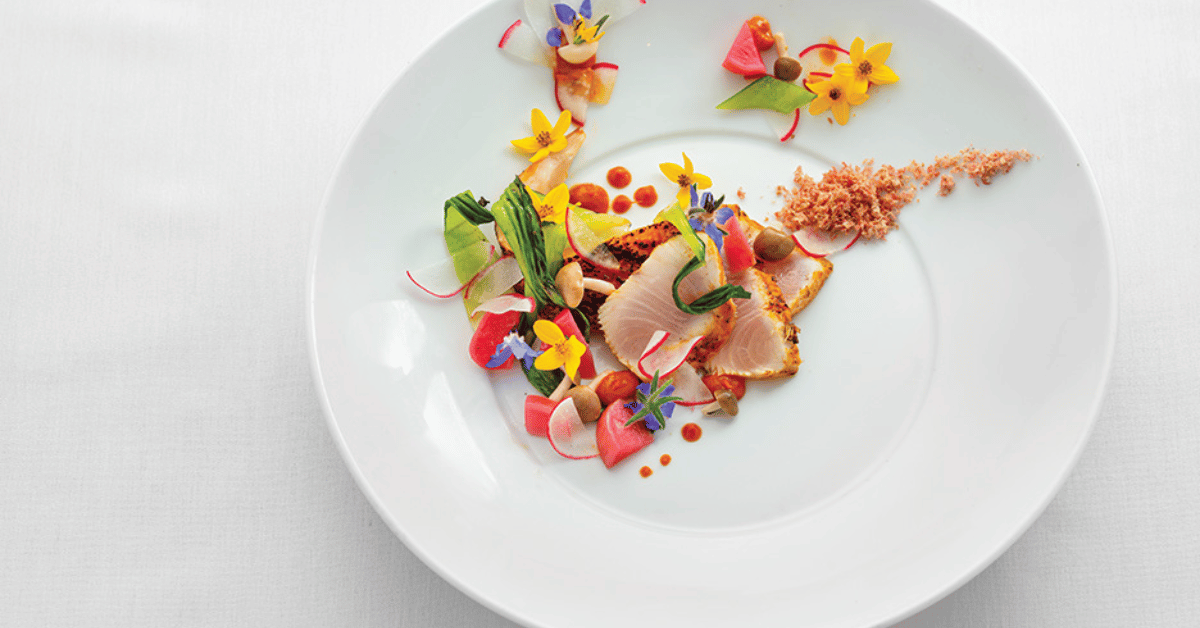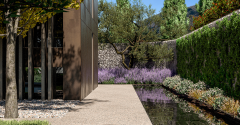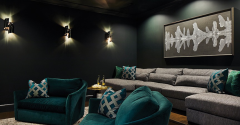Adding yellow accents to a room can be tricky: while it can transform a dull design to a bright and airy space, anything too harsh can cause the opposite effect. Luckily, there’s a foolproof way to designing a space with the color, and it can be a breath of fresh air whenever you walk into the room.
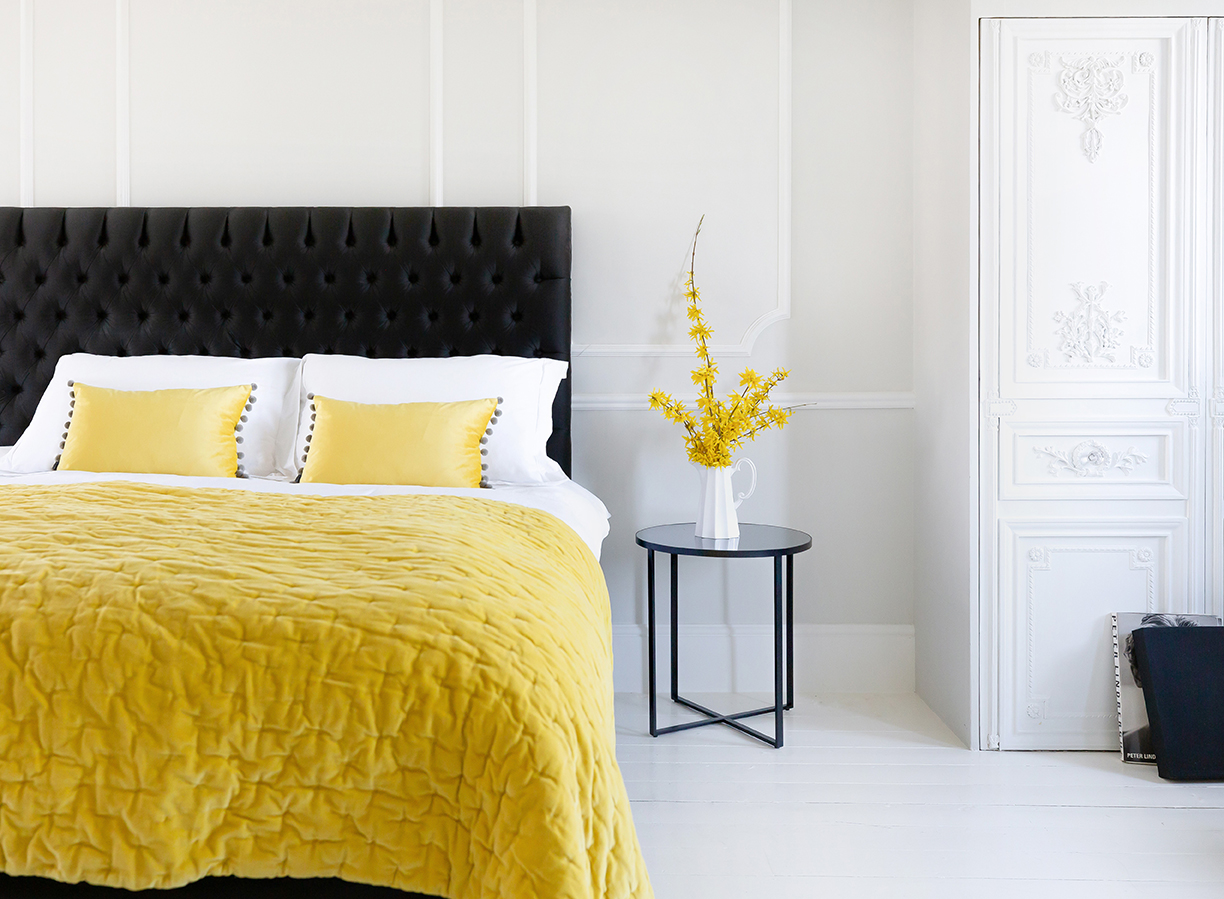
Photo courtesy of The French Bedroom Co.
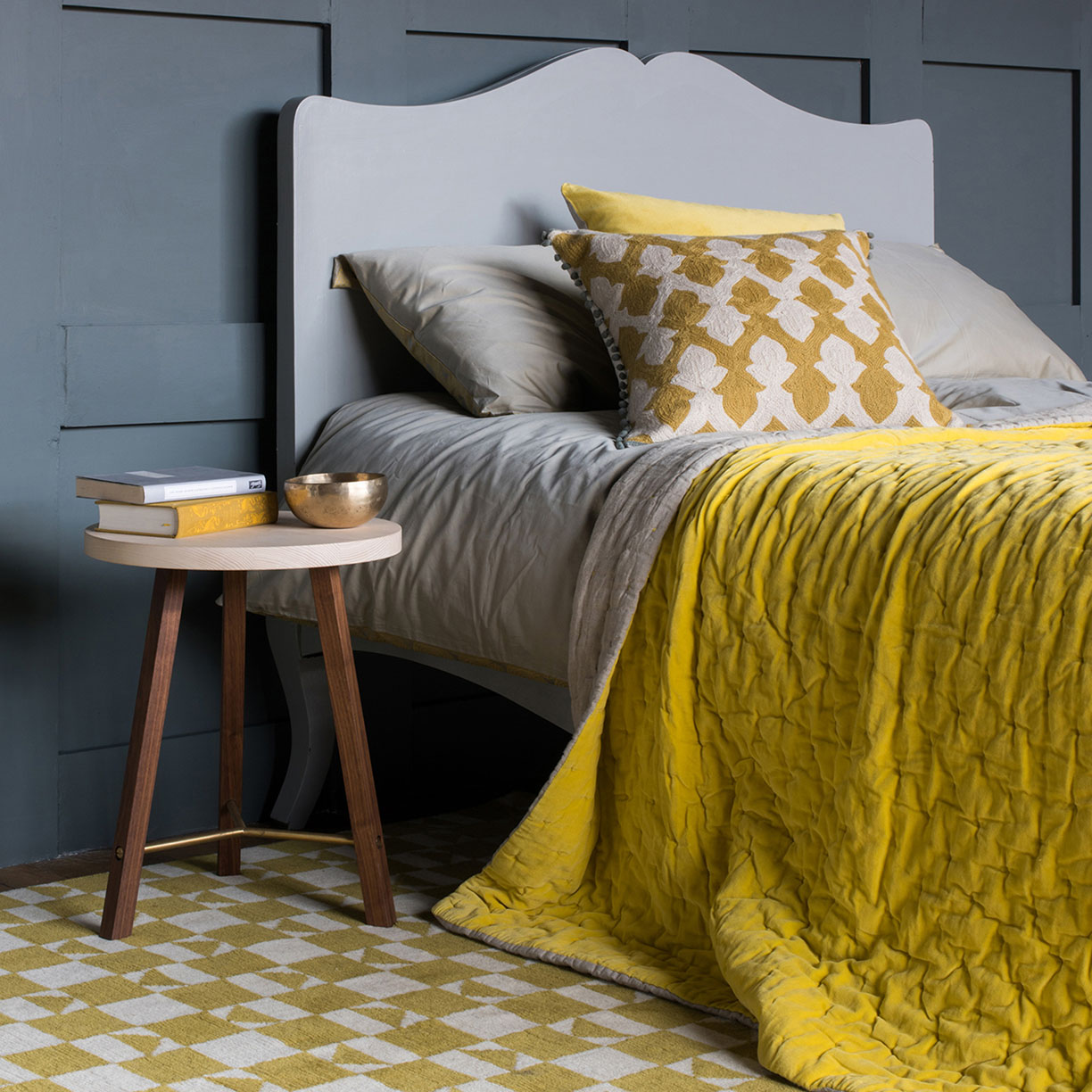
Photo courtesy of The French Bedroom Co.
When it comes to bedrooms, it can be difficult to choose the palette. While yellow walls may be too overbearing, yellow anywhere else may not be enough to do the trick. That’s why these two bedrooms have designed their spaces with two main categories: a bright yellow and a neutral color, such as grey, white or brown. They both balance each other out perfectly, with the yellow still adding that pop without being too harsh. The combination of hues adds to the comfortable and stylish decor, creating a space that’ll both brighten you up in the morning and be a calm retreat at the end of the day.
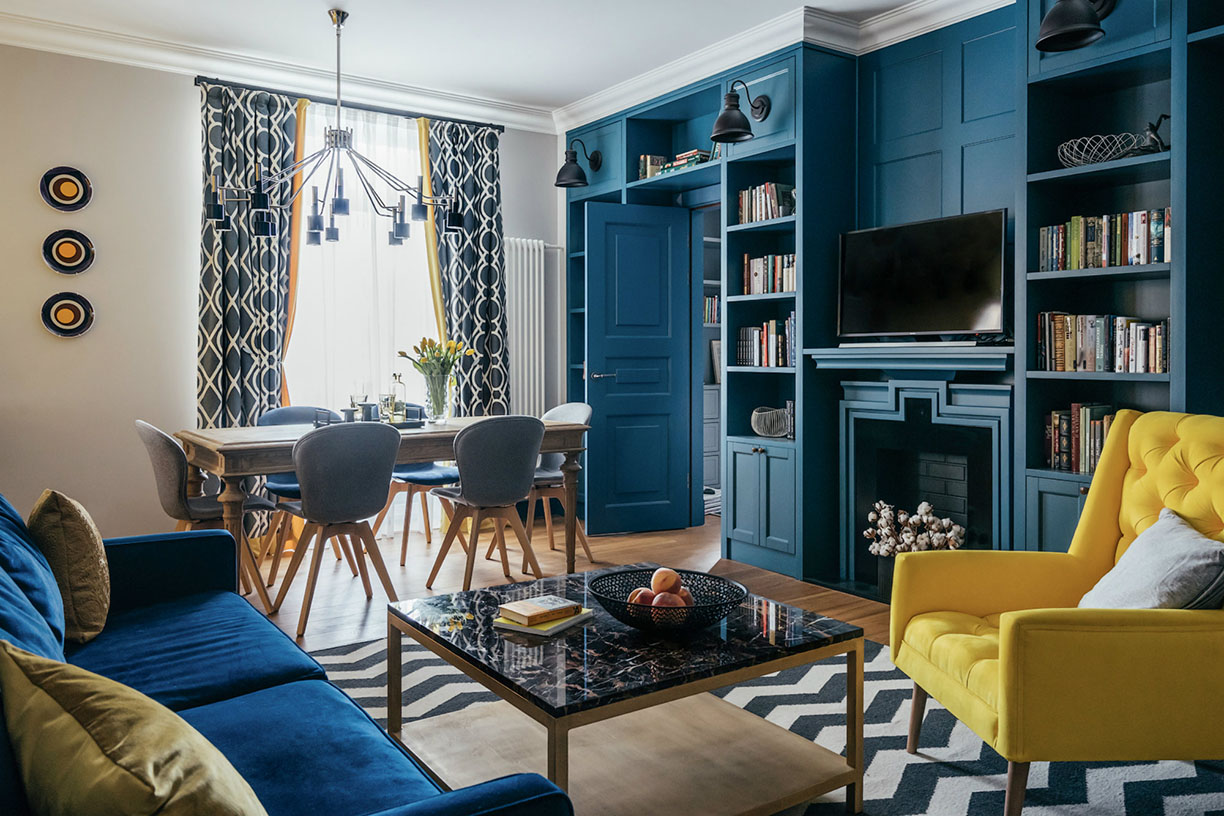
Photo courtesy of DelightFULL
Creating a living room with just a hint of yellow can add the perfect accent. This room that’s almost completely blue has a beautiful addition found with the bright yellow chair. It creates the perfect balance between the colors, creating a space with a unique and alluring charm.
The main trick with designing a room around the color yellow is to pick the right tones. The yellows shouldn’t be too harsh or overbearing, otherwise it will bring an unappealing style to the space. Meanwhile, the main colors of the room should be more neutral yet distinct from the yellow. Clear whites and dark browns and neutral grays play well here.
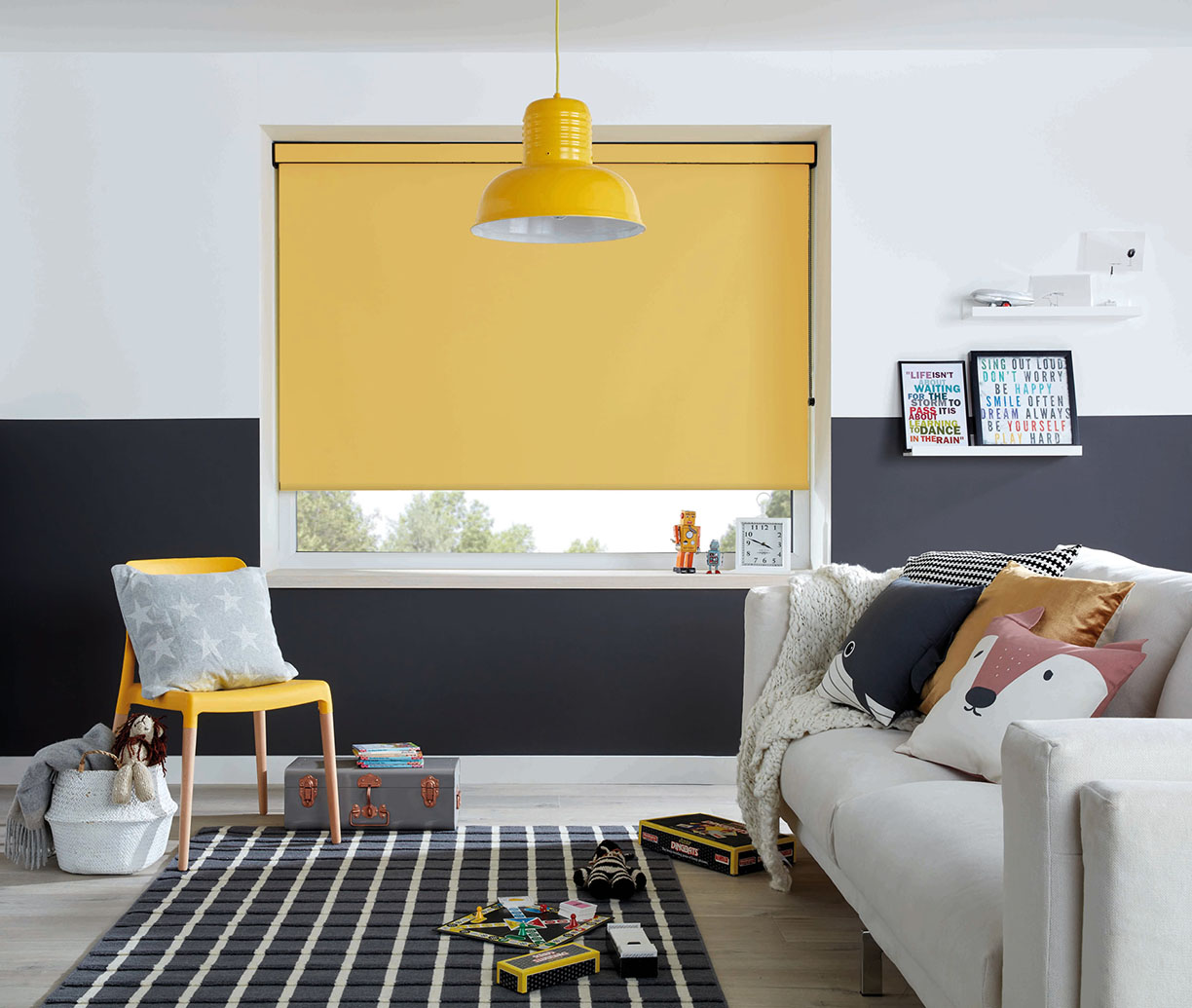
Photo courtesy of English Blinds
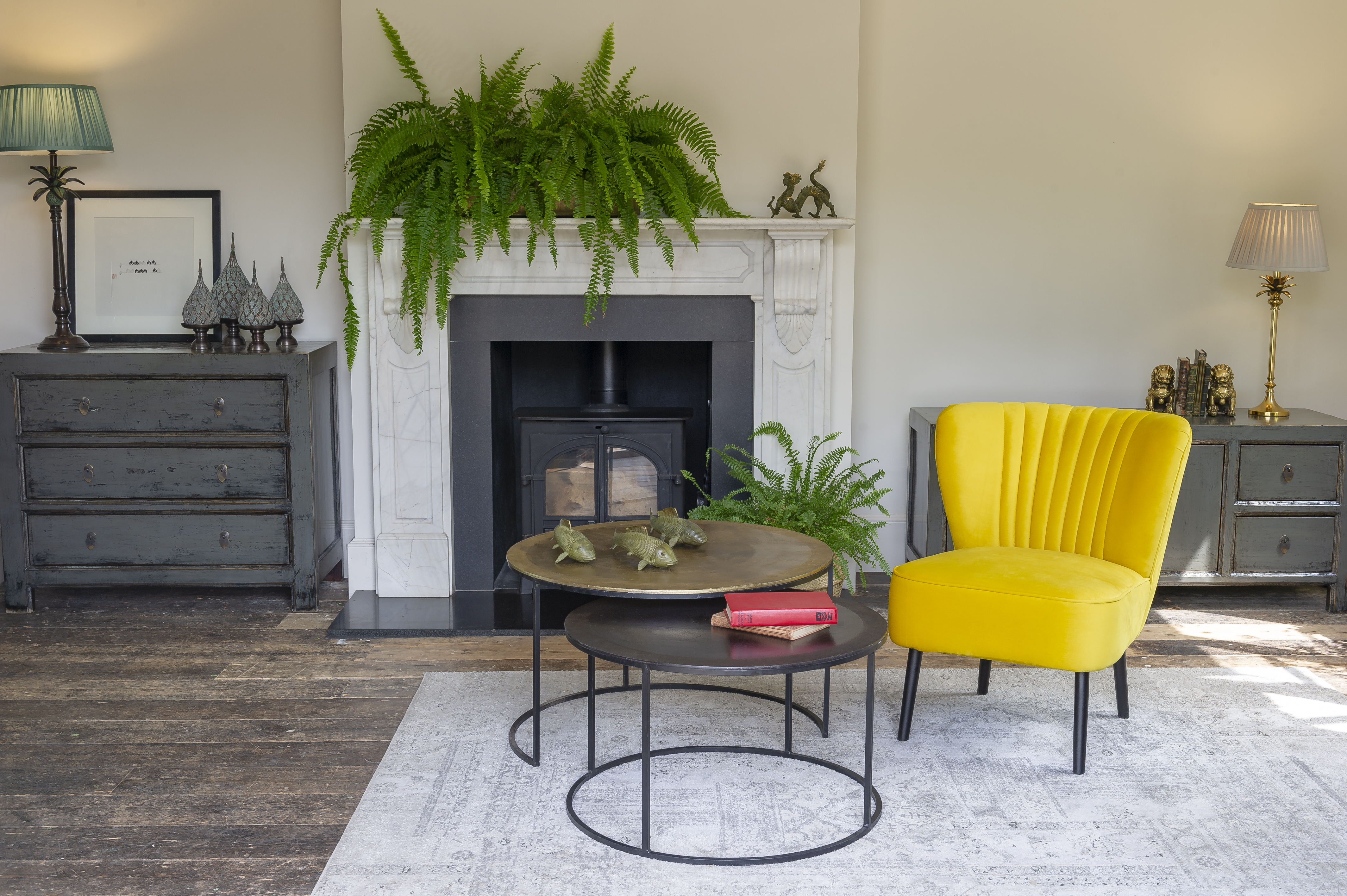
Photo courtesy of Orchid Furniture
Incorporate fresh plants to add another hint of color without making the space look disorganized or messy, and you’re on your way to creating the perfect space that’ll brighten up your day the moment you walk in.
When designing a child’s bedroom, the typical idea is to create a space with a bright, happy atmosphere. Finding the line between fun and playful to childish and unfashionable can be a thin one. It’s important to keep this space clean and stylish, without making it too modern or uncomfortable. Here are a few ways to find the perfect balance:
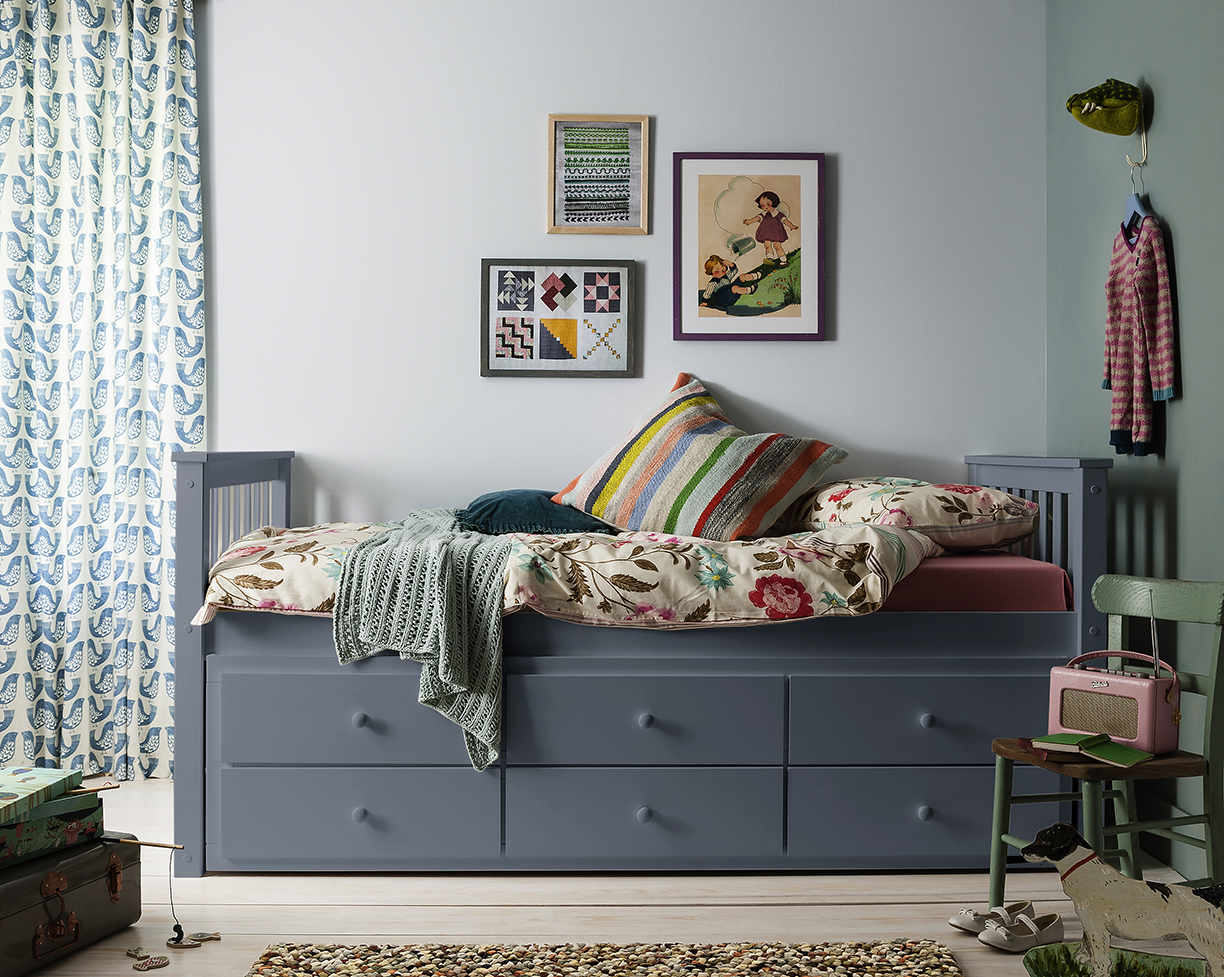
Photo courtesy of Noa and Nani
1. Storage Space
The many toys and games a child has creates the need for just as much storage space to organize it all. To keep the clutter away, choose a bed frame that includes built-in storage underneath. The mess that’s usually found under a child’s bed is now tucked neatly away in drawers, to create a comfortable and relaxed atmosphere.
2. A Colorful Canvas
The key to decorating a child’s bedroom is balancing the tones and color schemes, in order to create a happy childlike atmosphere. Look toward colorful pieces to balance out more subtle tones. This way, the space will look warm and inviting while not feeling cluttered and chaotic. A bright, colorful rug like the one below can add a fun, youthful piece to an otherwise modern room. Shelving is also a great way to add color to a child’s room. While not too overbearing in its appearance, the bright color is a modern and stylish way to keep a kid’s room on trend.

Photo courtesy of Go Modern
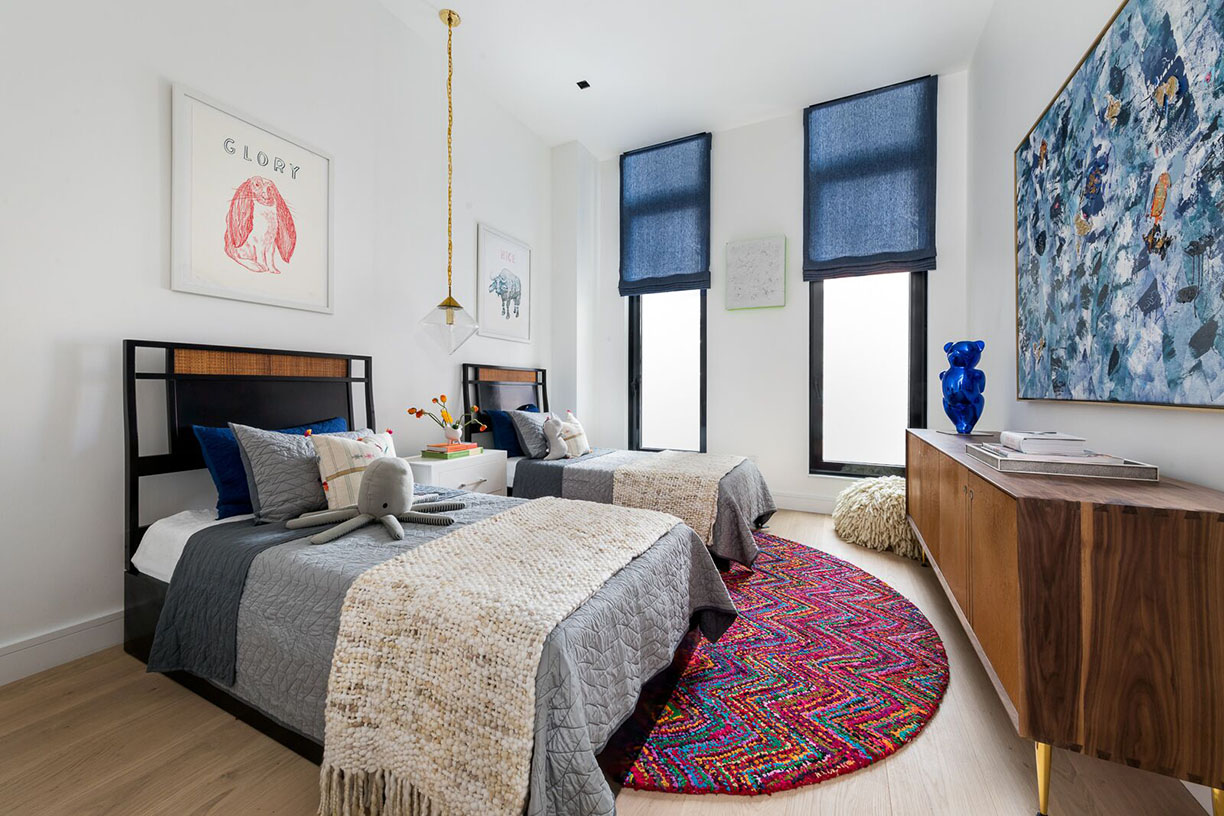
Photo courtesy of 111 Leroy
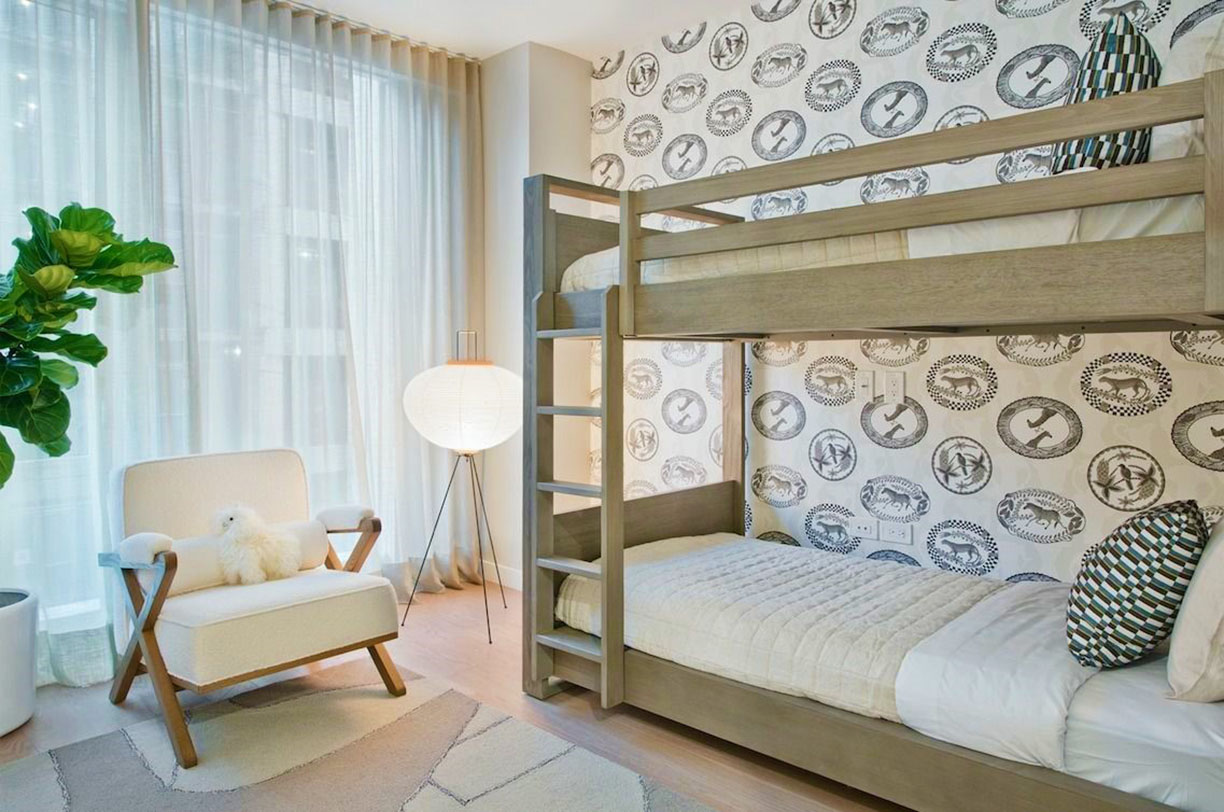
Photo courtesy of The Alyn
3. Balance Between Modern and Warm
Designing a child’s room is also finding a balance between modern and functional while creating a warm and welcoming space. The goal is to avoid scattered and outdated designs. A designer’s trick is to use both warm and colorful tones with function in mind. Deep greens, browns, reds, and blues create a sanctuary that’s both stylish and comfortable. In this bedroom at the Alyn, shown below, a neutral color palette alongside other playful elements to maintain the balance.
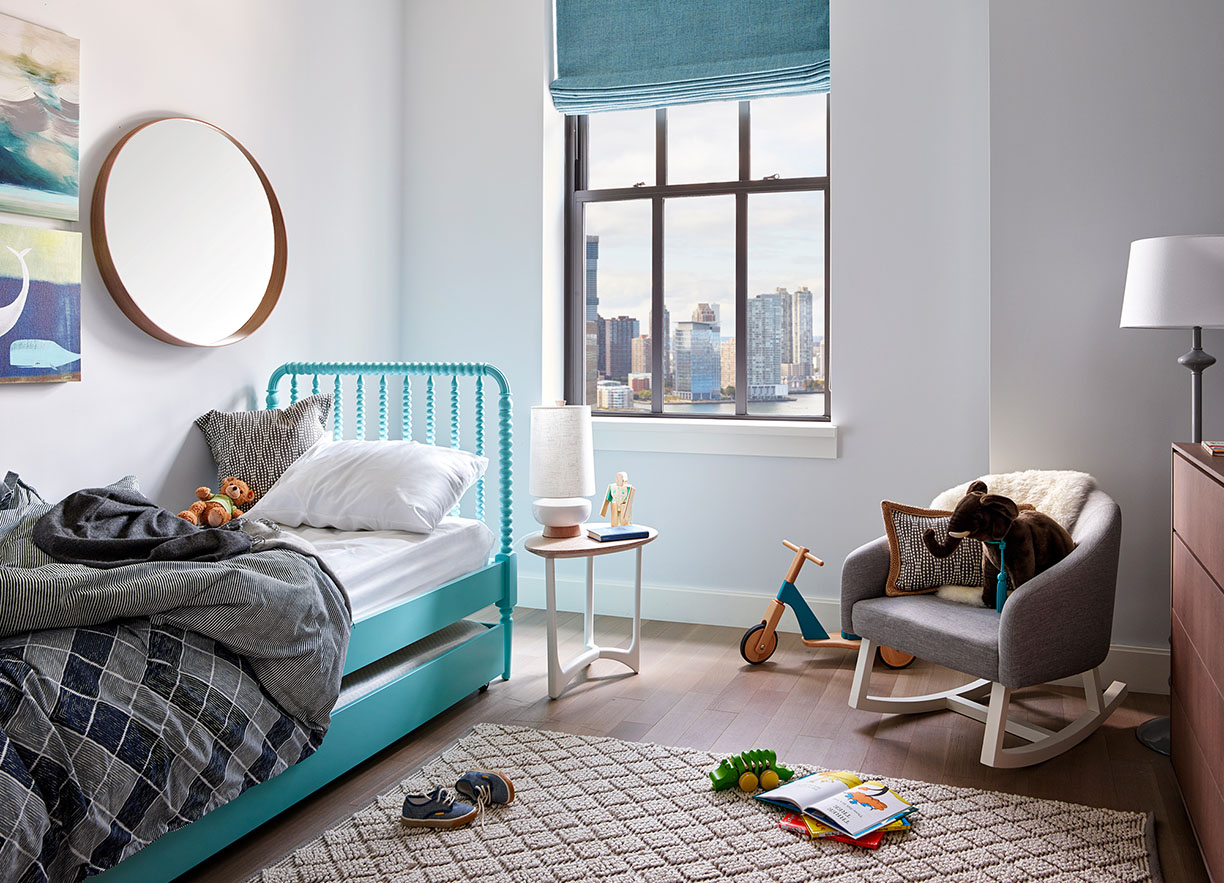
Photo courtesy of 100 Barclay
No matter the lifestyle, wellness and the pursuit to live better has been a rising trend in today’s world. In 2018, Pinterest reported that searches for “self care” were up 140 percent year-over-year, with no mention of stopping. Recently surveyed by national paint brand Sherwin-Williams, homeowners and professional interior designers have also noticed this uptick in wellness and how it affects modern home design and décor. Looking to make your spaces “healthier”? Check out these recent trends to see how you can incorporate wellness into your home styling.
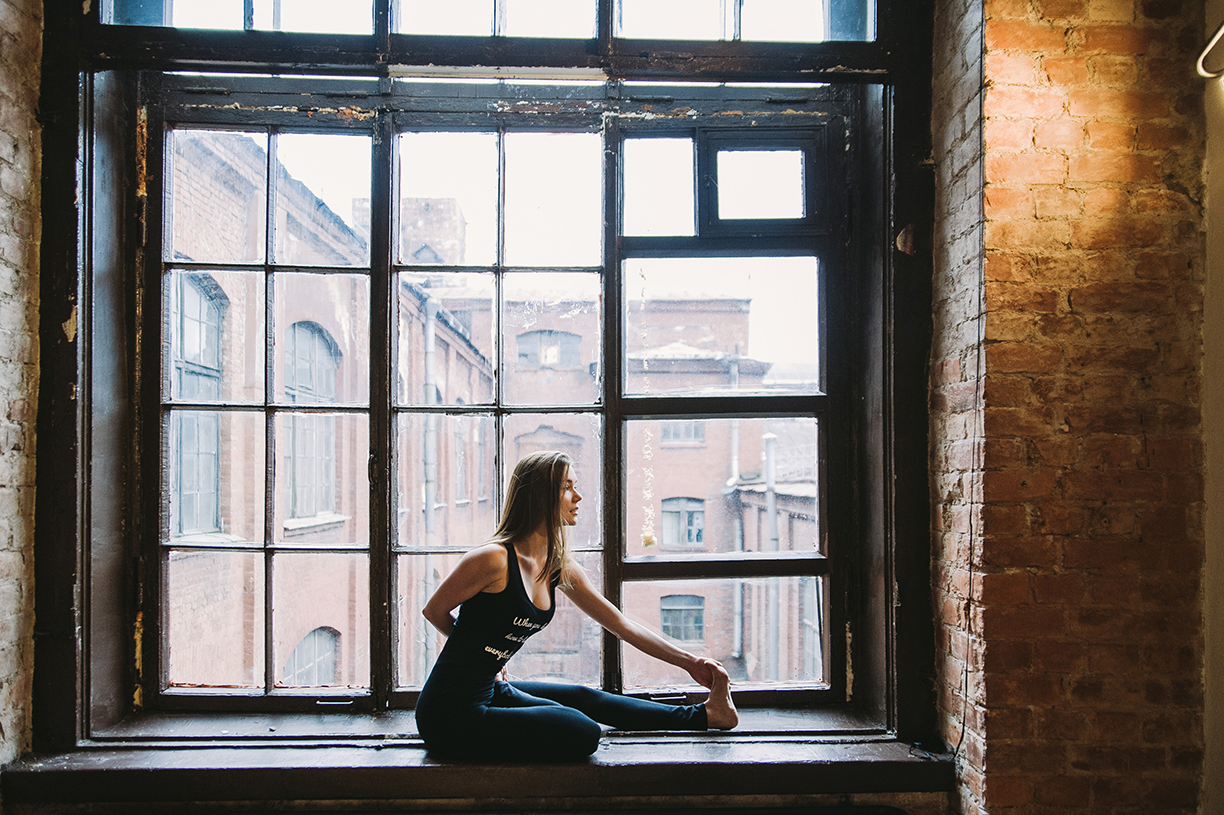
Self-Caring for Your Space
People are taking self-care beyond their body and into interiors. According to the survey, nearly 42 percent of designers say they have been asked to incorporate self-care into their designs. Twenty-nine percent of homeowners also take self-care into consideration when decorating their home.
The most popular way to bring wellness into a space also happens to be one of the easiest — natural light. Eighty-seven percent of designers use natural light to effortlessly reflect wellness.
Photo by Daria Shevtsova
Breathe It In
Improving indoor air quality is key for homeowners and designers looking to make changes. Over 54 percent of homeowners cite air quality as away they bring wellness into their homes, and 58 percent of designers use it as a tool to incorporate wellness.
Limiting volatile organic compounds, or VOCs, that are released through building materials is one of the best ways to improve air quality. This is done by using lower-VOC paints and other home improvement products that are sustainably sourced and have a low-carbon footprint.
Photo by Anamul Rezwan.

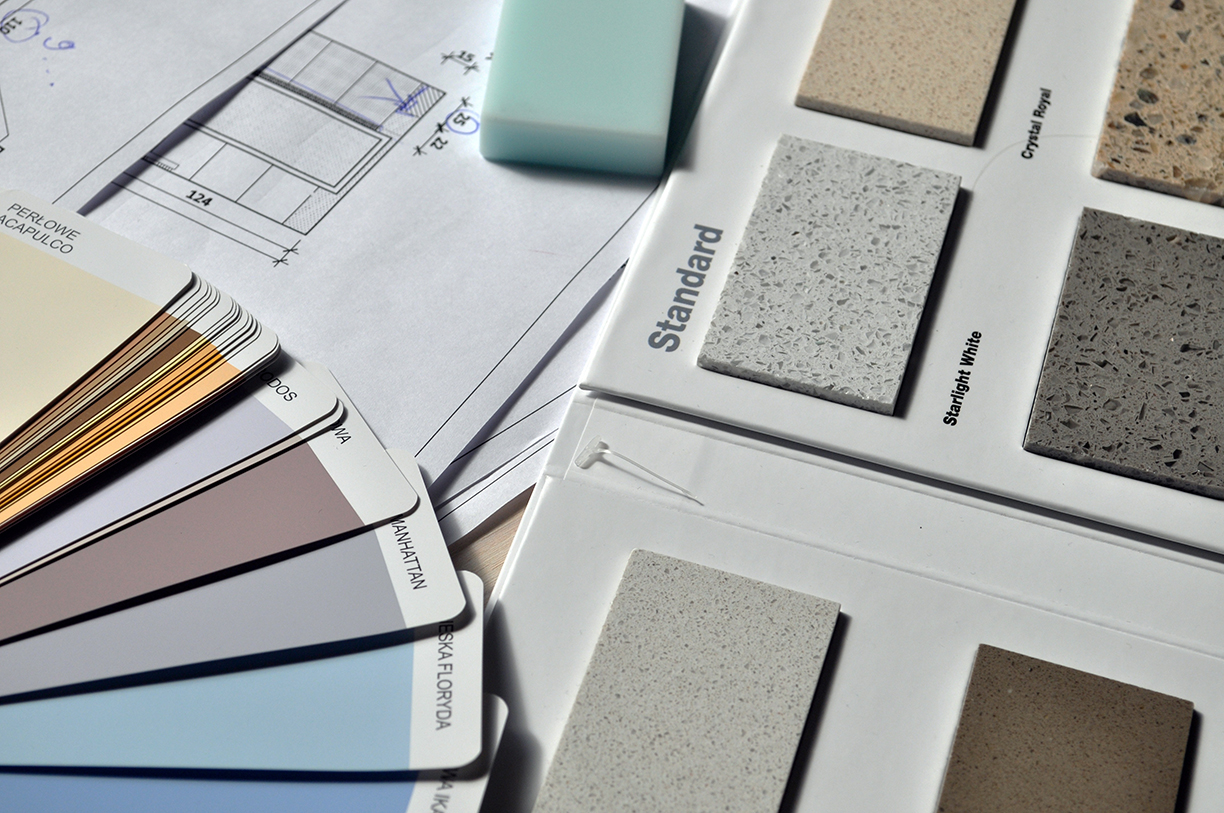
Color
When it comes to color, designers and homeowners do not see eye to eye on their top color choice that represents or stimulates wellness. Nearly 41 percent of designers say that green associates the most with wellness, whereas 34 percent of homeowners believe this color to be blue. Another popular color is white/gray, which 11 percent of designers and 18 percent of homeowners associate with the trend.
The color least likely to be associated with wellness? Red. Not a single designer and only 1 percent of homeowners reported that they associate this hue with wellness.
Photo by Pixabay.
Total Zen
In regard to specific spaces that are designed to promote wellness, homeowners different on their choice of which space was the best to achieve “total zen.” The top choices included a gym/fitness room (41 percent), a reading room (41 percent), and a greenhouse (38 percent). These choices differed from designers, who say that the most popular wellness rooms they’ve been asked to design in the past year include a reading room, a sauna/spa, a gym/fitness room, or a meditation room.
No matter the space, these insights into the wellness trends of today may better help you to find the wellness you crave from the comfort of your own home.
Photo by KatjaFiona.
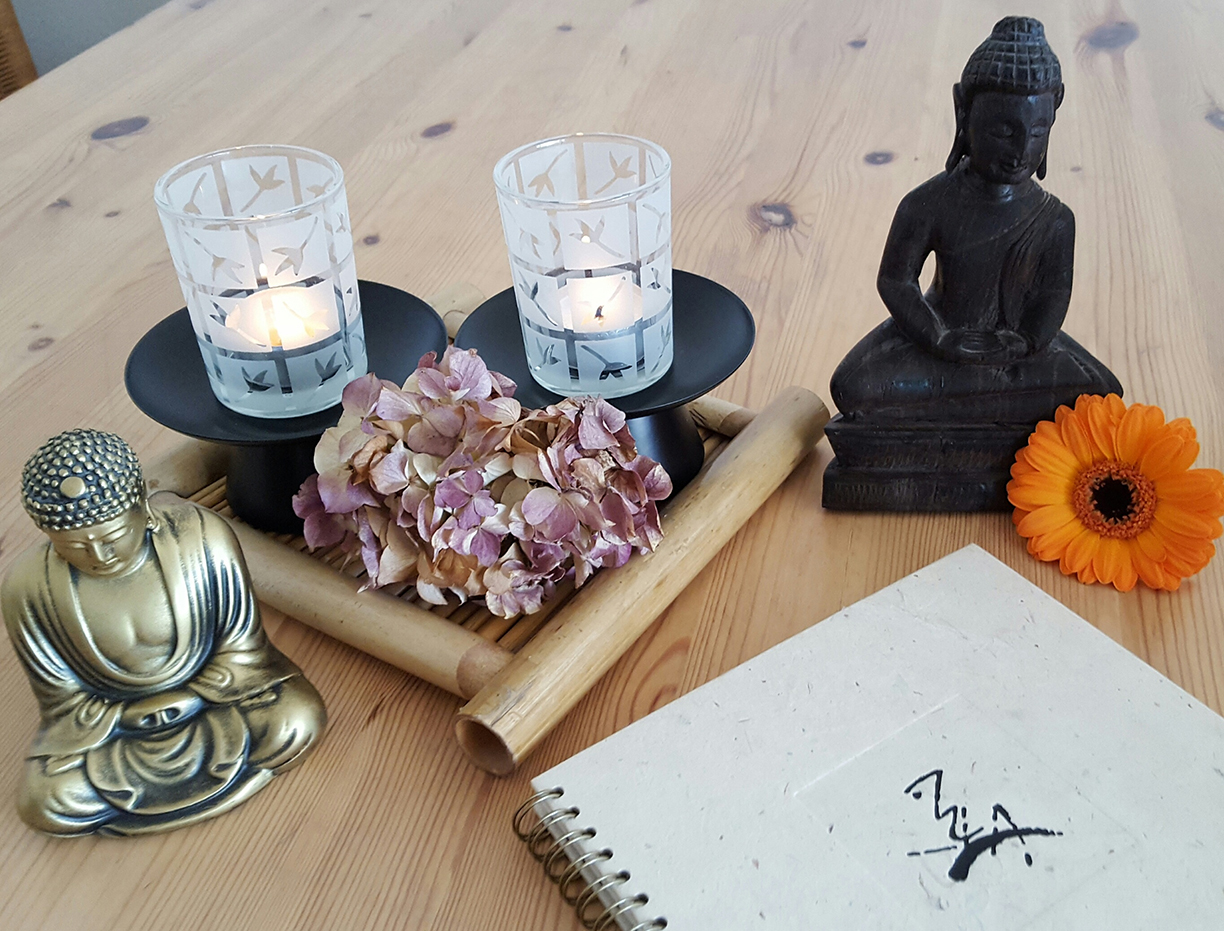
While dark-colored walls can add a depth to a room, it can sometimes be tricky to style around them. Every dark-colored wall brings a heavy tone with it, and it’s important to know how to design the space so has a balanced tone. While it’s a designer’s challenge, here are different rooms that prove it can be done:
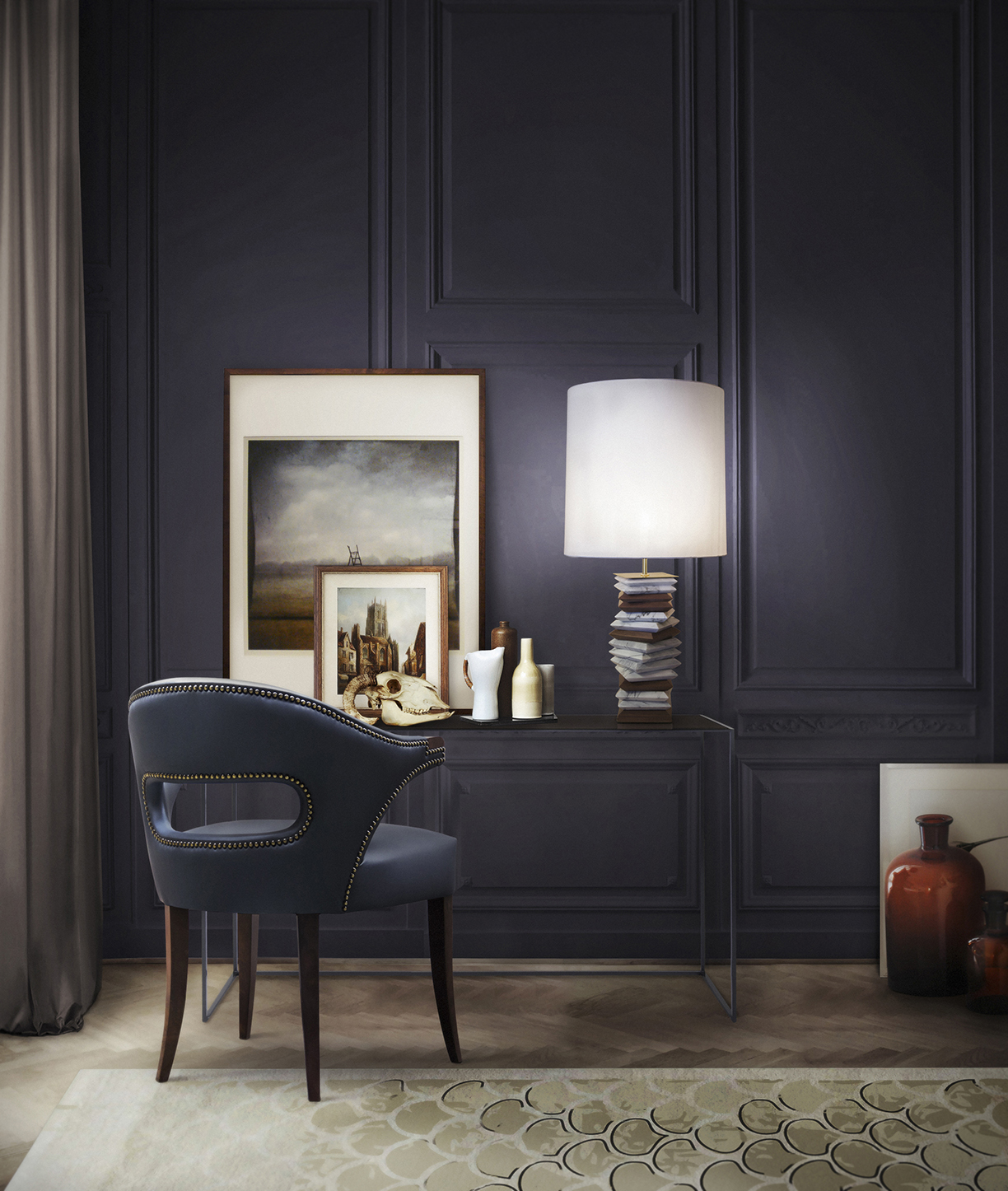
Photo courtesy of Brabbu Design Forces
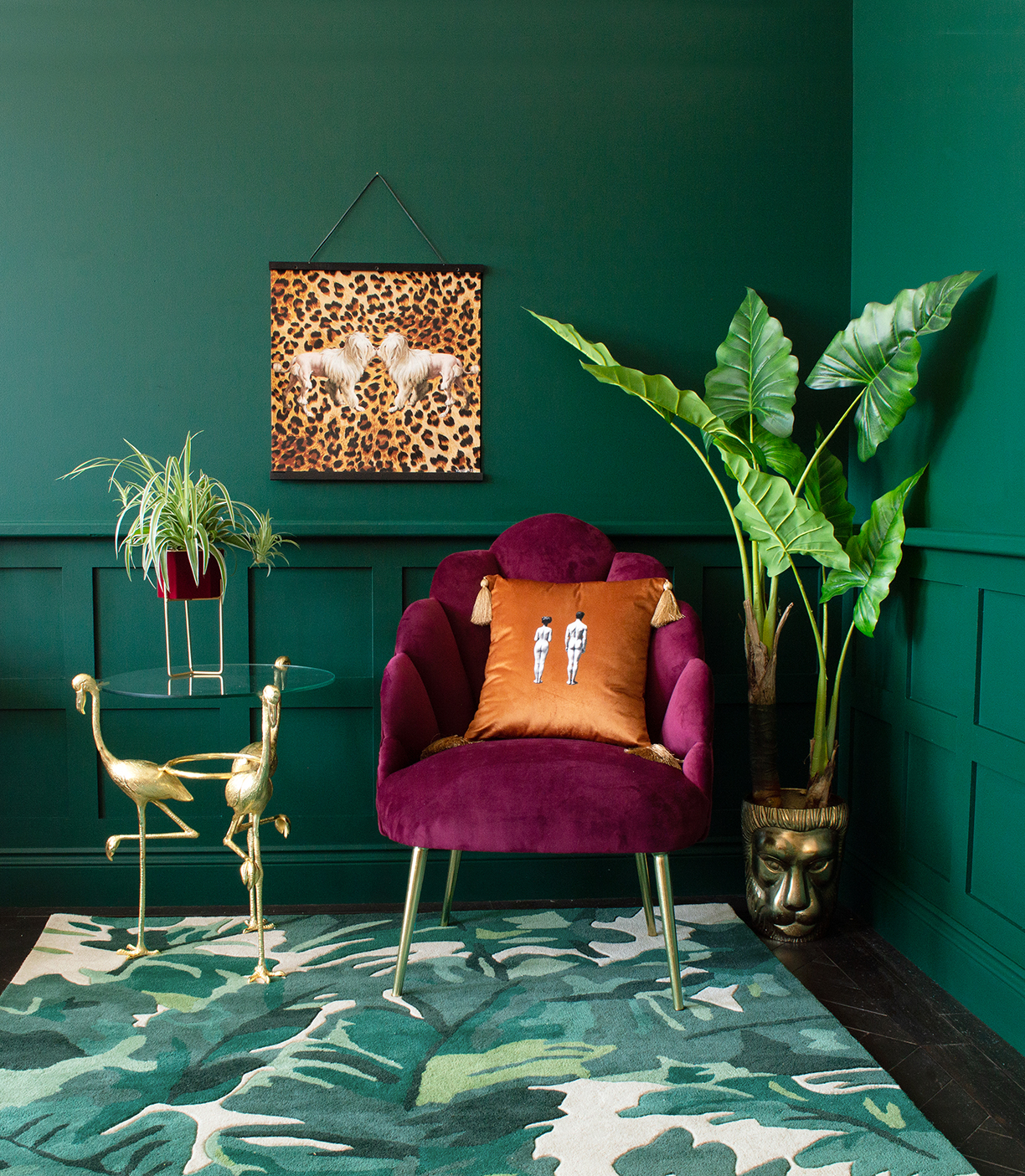
Photo courtesy of AUDENZA
1. Brighter Colors, Warmer Tones
When designing any room, it’s crucial to look at the colors you’ll be using and make sure they balance each other out. This is especially so for rooms with dark-colored walls. While they add a great tone to the space, too many darker tones can make a room feel cold and uninviting.
The perfect balance of colors involves a mixture of both darker and lighter colors, such as this bright red chair in front of a dark green backdrop. The chair adds a pop of color, making the dark colored walls feel warm and inviting.
1. Light versus Dark
Balancing the lighter and darker tones can be a challenge, since having too much of one can overwhelm and wash out the other. These baths represent the perfect balance of tones. The darker walls counteract against the polished bathtubs and light fixtures. This not only adds a great balance, but brings a rich and inviting depth of color to the room.
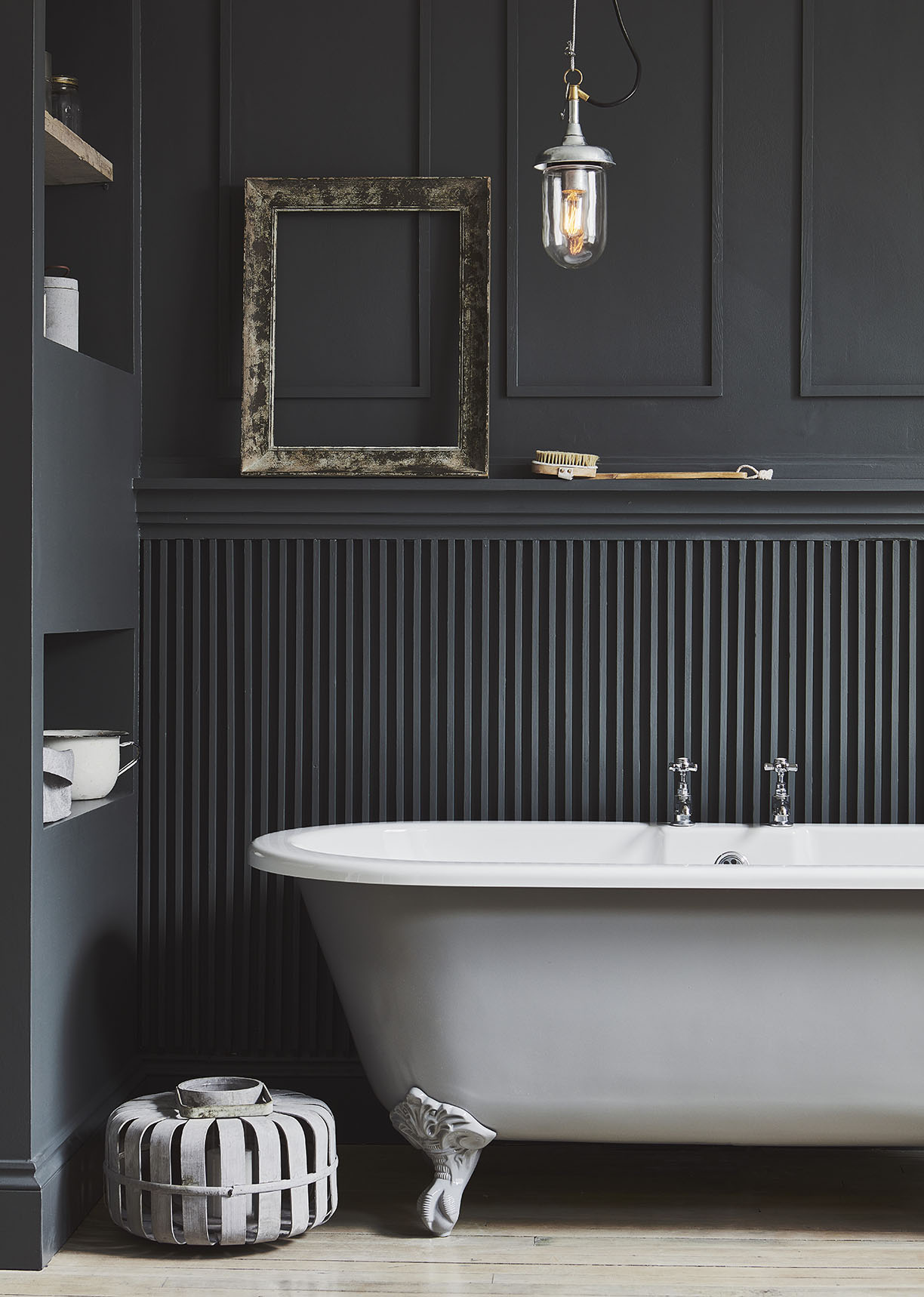
Photo courtesy of Garden Trading
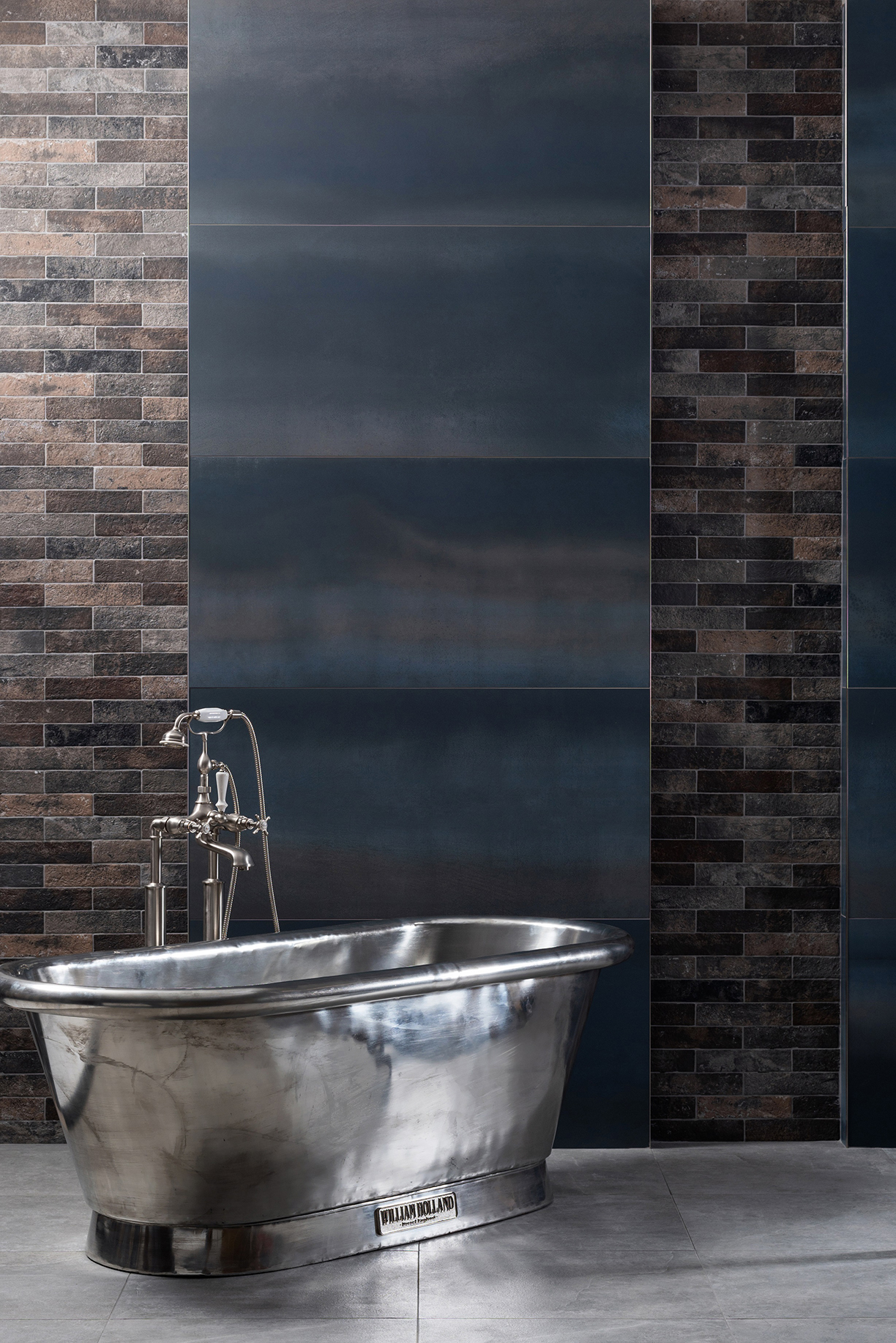
Photo courtesy of Original Style
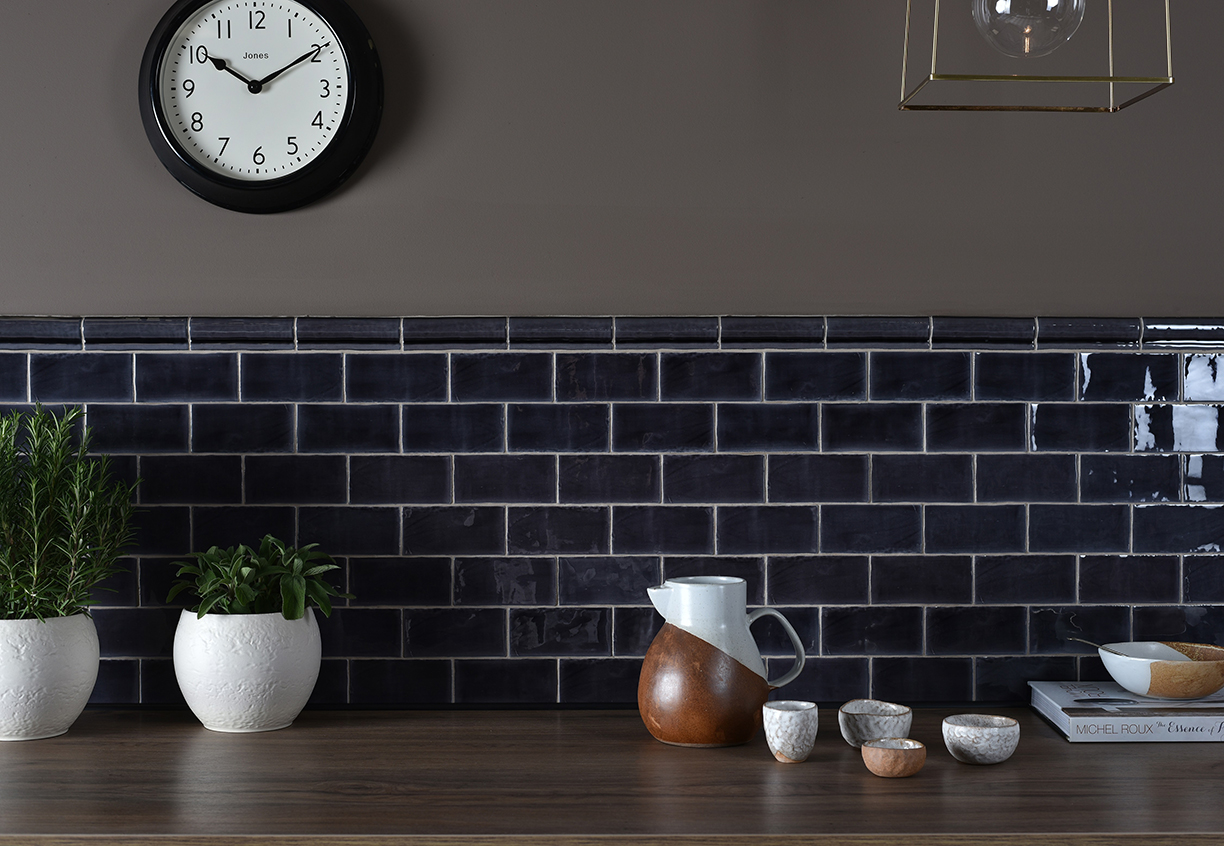
Photo courtesy of Original Style
3. Allowing Tones to Stand Out
When it comes to dark-colored walls, an immediate response may be to counteract the heavier tones with lighter statement pieces. While this can create a beautiful design, it’s important to allow the rich, dark colors to stand out. In this kitchen, there are minimal pieces that are lighter in color, allowing the walls to be full in color and provide a warm and cozy atmosphere.
With more than 65 years’ experience between them, Sheryl Chinowth and Lee Cohen, co-founders of Chinowth and Cohen Realtors, have proven to be leaders in the luxury real estate industry. Their experience has granted them the Lifetime Achievement Award at the Who’s Who in Luxury Real Estate (LRE) Fall Conference, being held in Washington, D.C., from September 24 to 27.
Their firm has received several recognitions since its establishment in 2004, including ‘Best in the World’ Real Estate Company by Tulsa World readers in 2015 and 2016, along with ‘Best of the Best’ Real Estate Company in Tulsa by readers of Oklahoma Magazine for six consecutive years.

Photo courtesy of Luxury Real Estate
Awarded twice annually to a longtime member of the LRE® network, the recipient of this prestigious award is selected by virtue of their outstanding peer recognition, relentless hard work and commitment to the real estate industry.
“Sheryl and Lee have grown one of the most successful real estate firms in the country. They are respected in the industry for their professionalism, hard work and commitment to their community,” said Who’s Who in Luxury Real Estate Chairman John Brian Losh. “It’s been an honor to call them friends and colleagues over the years.”
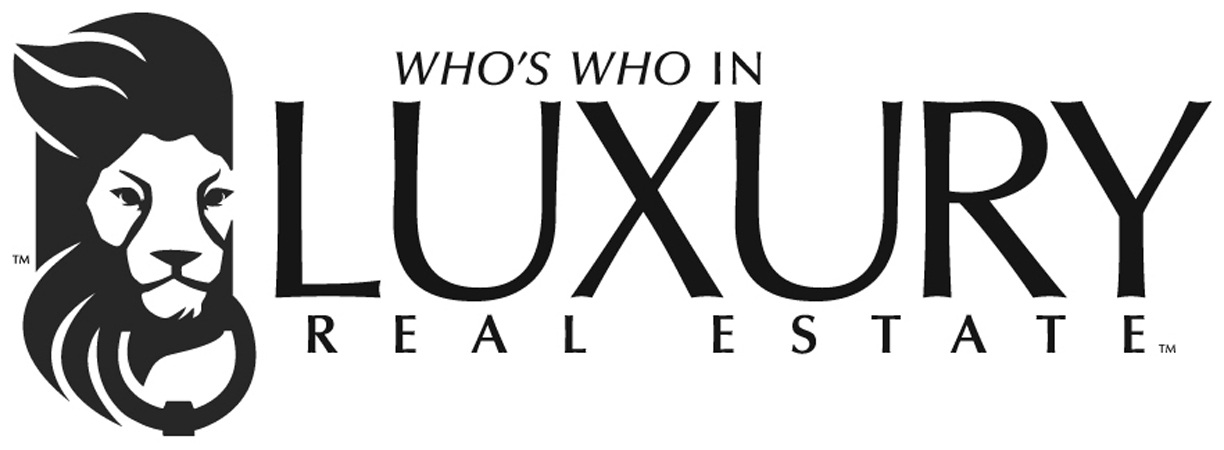
Photo courtesy of Luxury Real Estate
Along with being distinguished as a Top Realtor ranking in the top 3% nationally and top 1% in Tulsa County, Sheryl serves on the esteemed LRE® Executive Committee. She has previously received the LRE® Extraordinary Philanthropy award in 2013 for her commitment to giving back to the community.
Lee is currently active in the Greater Tulsa Area of Realtors (GTAR) RCA Committee, Legislative Committee and RPAC Committee. He is also a member of the Oklahoma Association Realtors Finance committee as well as a member of the REAL Trends Leadership Council.
With a sleek, modern style becoming the new trend in home design, chandelier makers are turning from the traditional designs to modern light fixtures instead. Not only do they add an elegant and modern piece to the room, but they’re becoming pieces of art in their own right.
The creativity that goes into designing and manufacturing these modern chandeliers is pushing the boundaries on the line that constitutes furniture and works of art. With that said, here are some tips on choosing which modern chandelier is best for you:
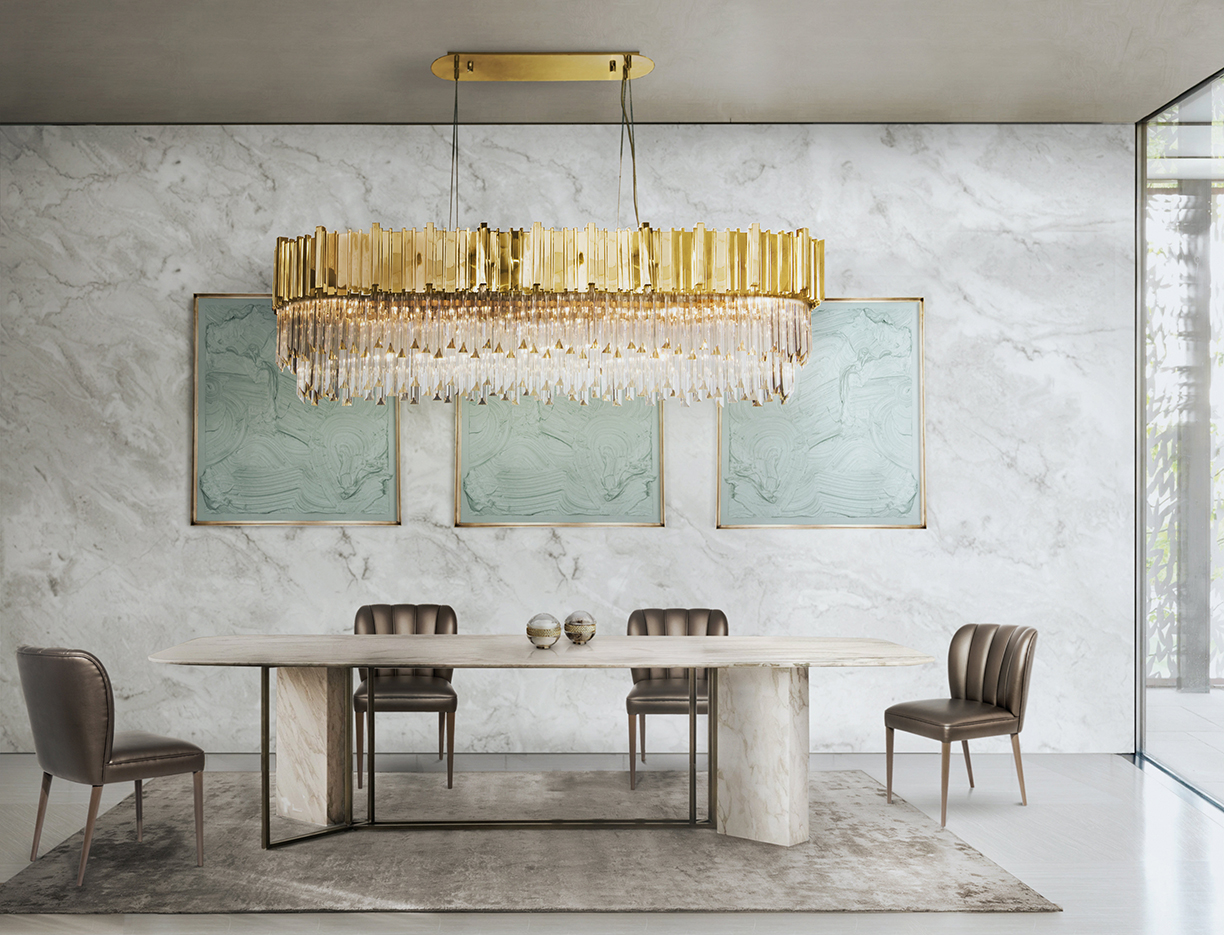
Photo courtesy of Covet NYC
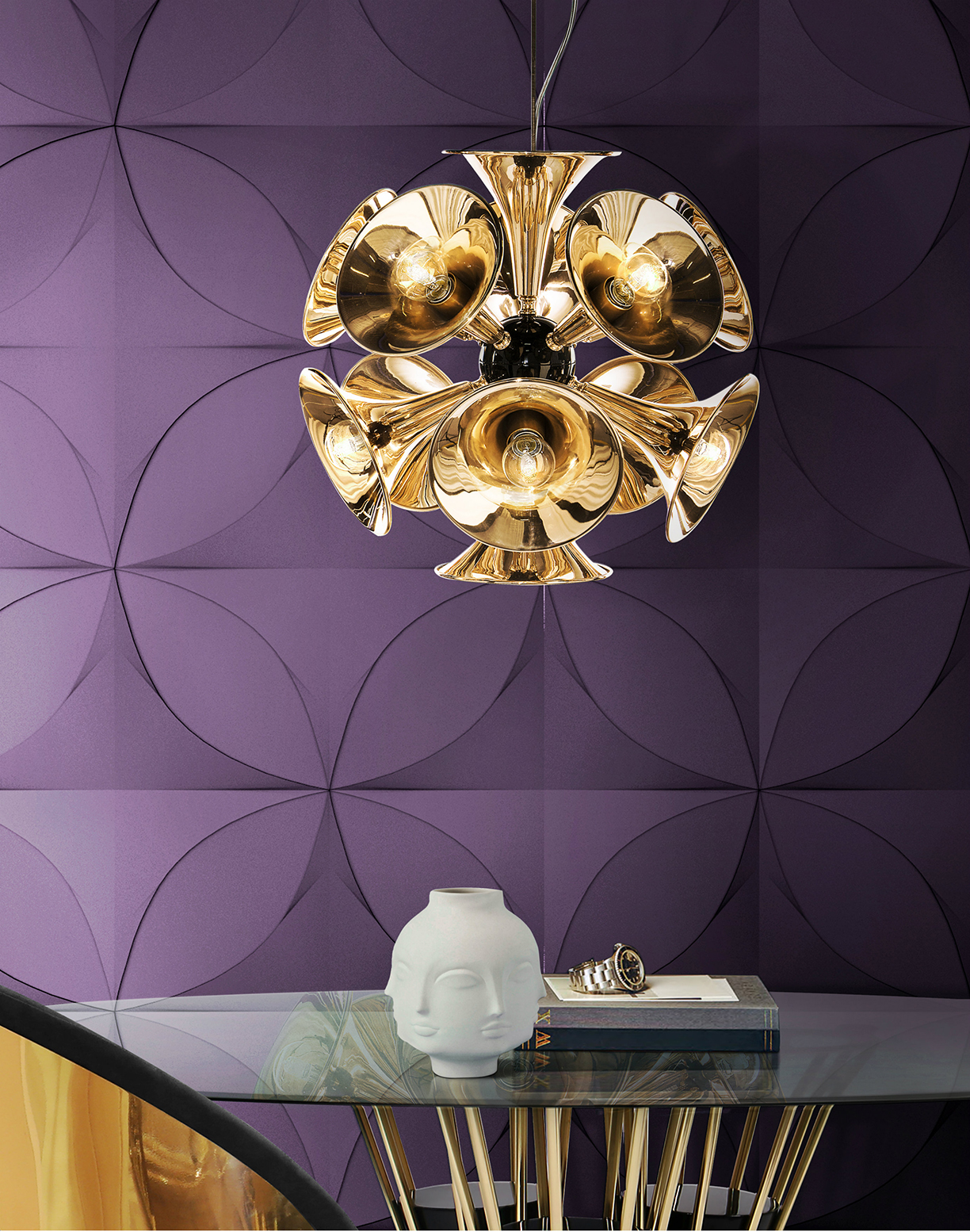
Photo courtesy of DelightFULL
1. Get Creative with Material
With any modern chandelier, the material matters. Getting creative with the material used to create the chandelier can add a great addition to the room’s decor. Creativity is proven to go a long way in designing the perfect modern chandelier.
The Botti pendant lamp, inspired by the American trumpet player Chris Botti, adds a fun twist by using trumpets as the main material of the chandelier. While still luxurious in its style and design, it adds personality and a conversation piece to the space. While the chandelier is more retro in its style, using a creative material and thinking outside of the box can be beneficial for whichever style is preferred.
2. The Space it Resides
Both small and large chandeliers can be a great addition to any space. It’s important, however, to consider the type of space when choosing which modern chandelier to include in it. For a foyer or room with high ceilings, look for a larger chandelier to create a major focal point. In spaces like dining and living rooms, a smaller chandelier will still be a work of art, yet it won’t take away from the rest of the design in the space.
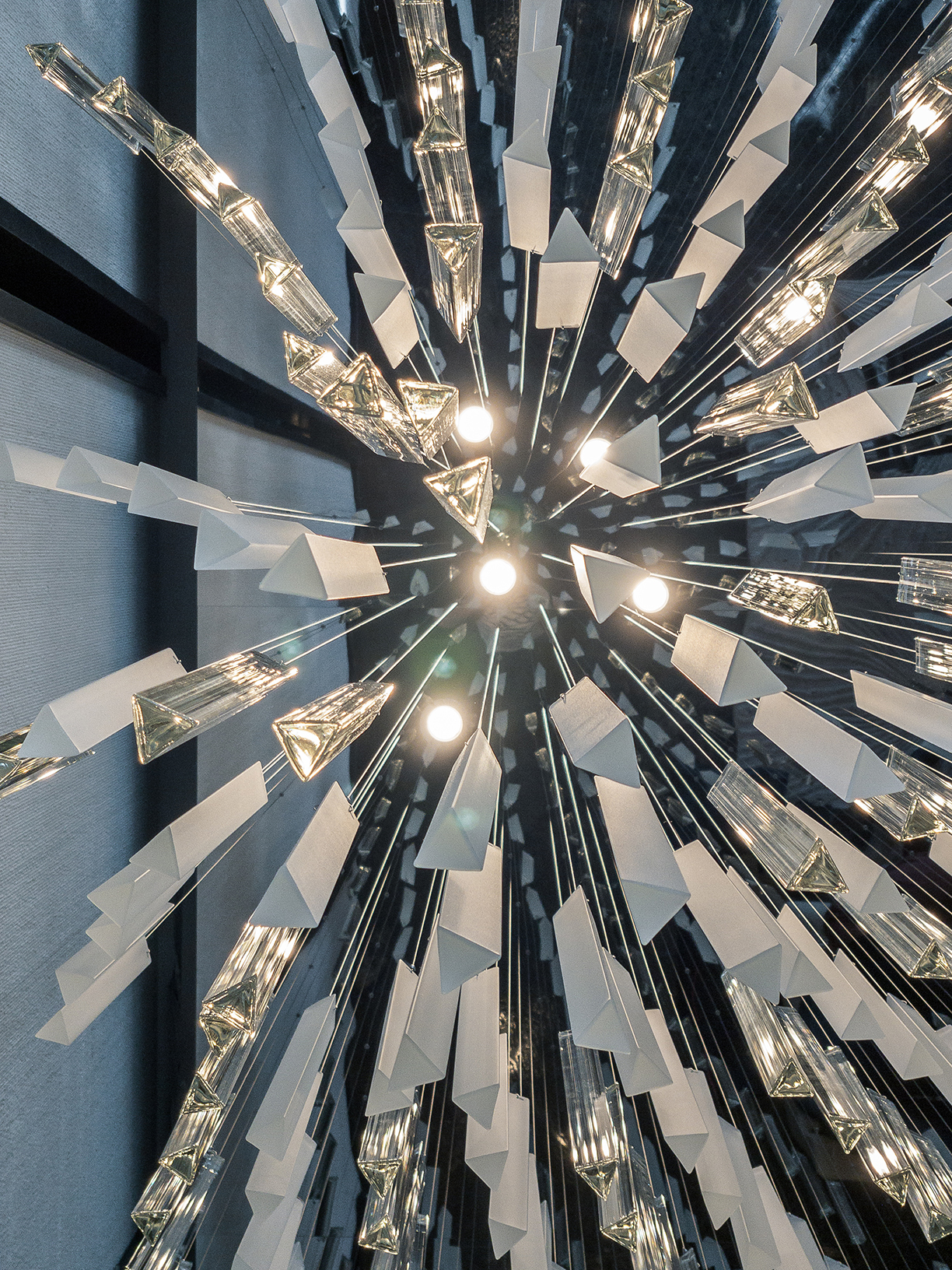
Photos courtesy of Muse Residences
In recent years, more and more hotels and apartment buildings are getting rid of the traditional designs and replacing them with modern and sophisticated styles instead. The modern chandelier in this residential building is certainly the focal point, simply for its sheer size and elegance. When visitors and residents walk into the building, they are in awe of its design.
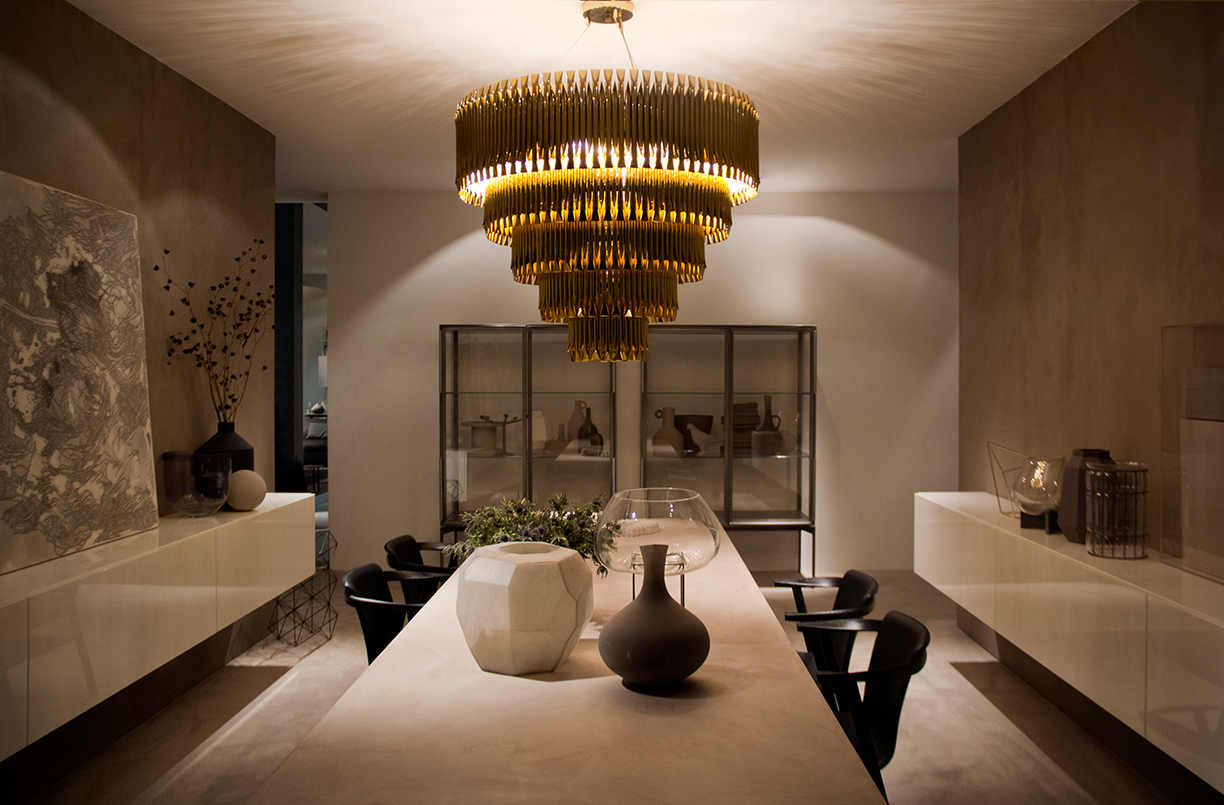
Photos courtesy of DelightFULL
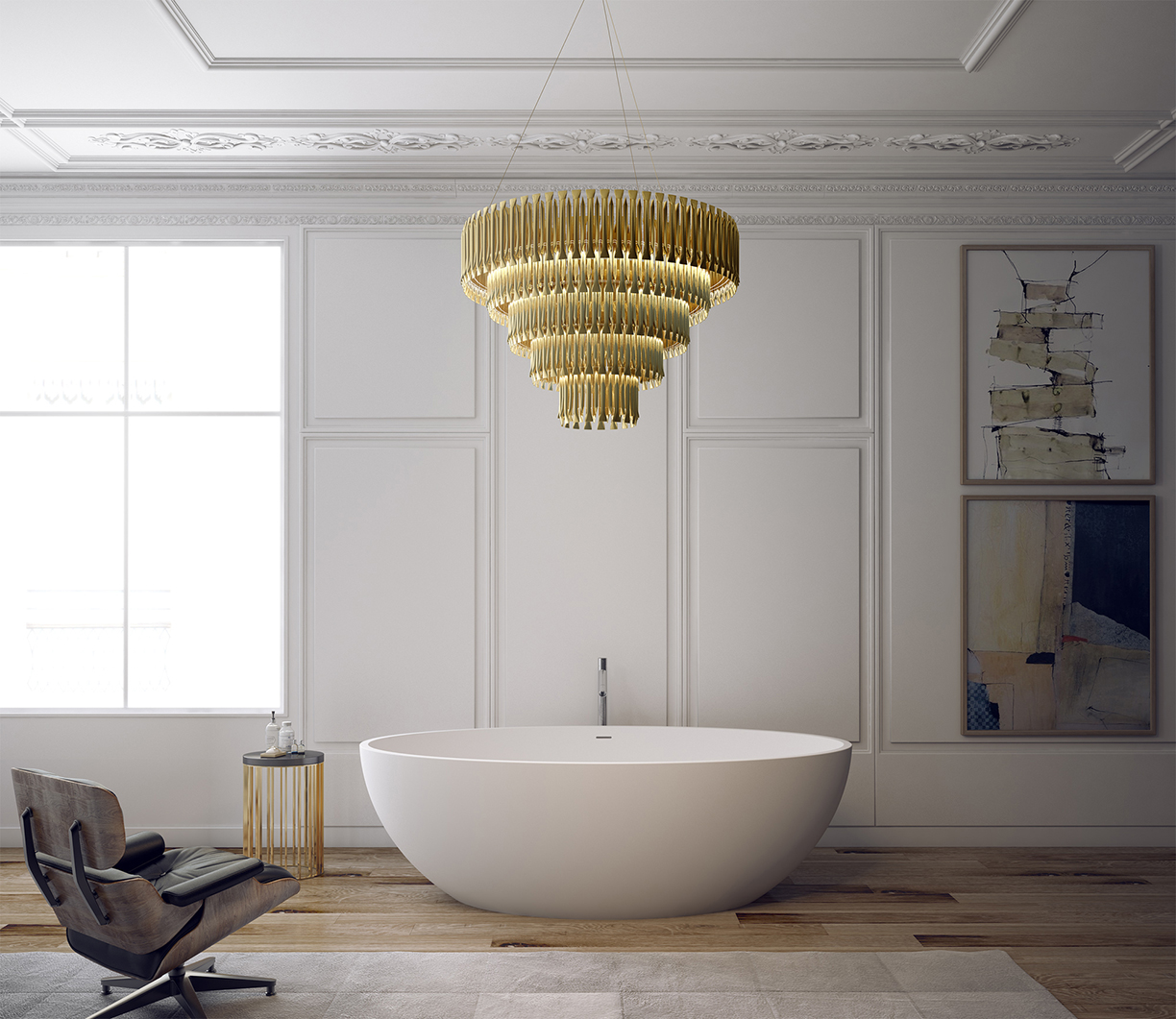
3. The Lighting
In terms of lighting, either a dramatic flair or a softer hue can be a great addition to any space. While the design and material of chandeliers can be similar, the lighting can make a major difference in the atmosphere in the space.
While the first chandelier provides a dramatic light in a darker room, the second provides a more subtle light in a room ample natural light. Both, however, add to the design and atmosphere of the space.
4. A Work of Art
Regardless of the material, design and lighting, it’s crucial to remember the creativity a modern chandelier allows. Whether it’s above a dining table, in the living room as a statement piece or the focal point of the foyer, modern chandeliers aren’t simply light fixtures anymore — they’re works of art.
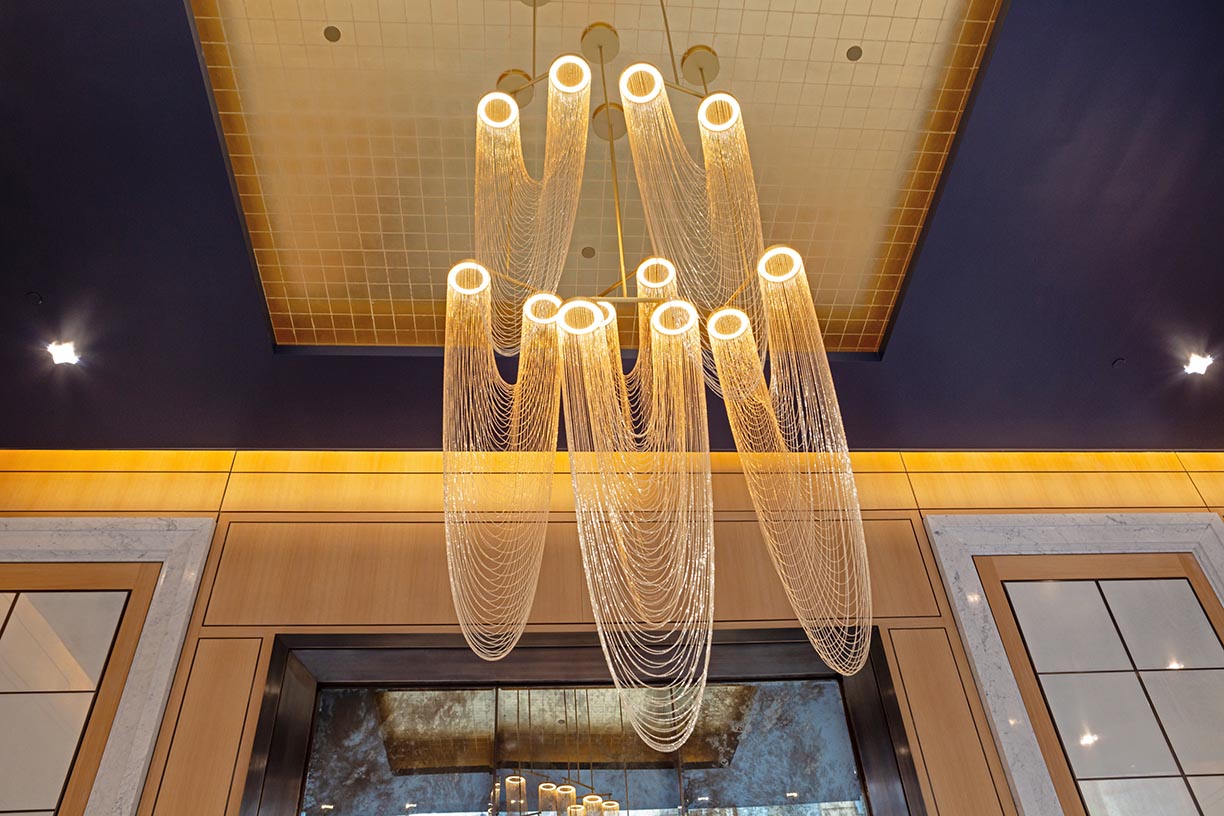
Photo courtesy of The Alyn
Offering a one-stop shop for high-end design — architecture, landscape architecture and interior design services under a single roof on Los Angeles’ famed Miracle Mile — is Studio William Hefner.
The office’s location on this stretch of Wilshire Boulevard, lined by Art Deco masterpieces and many of the city’s museums, is clearly inspirational for designers.
Originally from Northern California, Hefner arrived in Los Angeles to earn a graduate degree in architecture from UCLA and founded his current practice in 1989. He oversees a highly collaborative staff of about 35 in L.A. and maintains a smaller office in the idyllic coastal community of Montecito, outside of Santa Barbara.
Hefner, who studied art history in college and appreciates a diversity of design, draws inspiration from landmark residences scattered throughout Southern California. He is appreciative of traditionalists like Wallace Neff and Paul Williams — their Mediterranean estates have long been popular with Hollywood celebrities — as well as Mid-Century Modern masters Rudolph Schindler and Richard Neutra. As a result, Hefner’s practice encompasses a wide spectrum of architectural styles and his firm adapts to evolving preferences.
“In my practice, I try not to have a ‘signature’ style but strive toward quality design and execution in different genres, from very traditional to contemporary,” says Hefner, who reports about 60 percent of his current commissions are modern, a share that has doubled in the past decade. “Modern residential architecture has come in and out of style over the past 30 years but is finally becoming more of a lifestyle, not just a fashion or trend,” says Hefner, who adds, “I think it’s here to stay.” In Los Angeles — where so many high-end homes are in the hills or along the coast — modern design maximizes views and suits the region’s indoor-outdoor lifestyle.
Commissioned to design a massive residence on 10 precious acres in L.A.’s opulent Bel-Air neighborhood, Hefner created a formidable French-style estate known as Château des Fleurs. The client’s original inspiration was the majestic Hôtel du Cap on France’s Côte d’Azur, and Hefner conducted extensive research in Paris, Versailles and the Loire Valley to ensure that every detail was authentic. “We wanted to make sure each room was special and unique,” explains Hefner of the house, which has 31 bathrooms. Despite the scale of the project, the architect took care to create intimate, family-friendly spaces throughout the home in addition to grand rooms for entertainment.
When the 60,000-square-foot residence was completed in 2013 after five years of construction, it was the largest home in a city famous for conspicuous consumption. In his lavishly illustrated book Château des Fleurs (Pointed Leaf Press, 2016), Hefner explains a progressive approach to classic French design. “The balance of this house was to create a powerfully simple structure that would feel timeless and not imitative, while inviting an Old World opulence to the fit and finish of the architecture in a way that would be both decorative and something more: modern,” he writes.

Another more classically inspired design from Hefner is an oceanfront home in L.A.’s Pacific Palisades, a celebrity-favored enclave with a rich architectural history. This home features an Italianate design, dazzling spiral staircase and lush landscaping. In the very same community, in the foothills of the Santa Monica Mountains, Hefner authored a sprawling modern residence in which the floorplan was meticulously oriented to ensure optimal views from every room.
An approximately 7,000-square-foot home in Beverly Hills’ coveted Trousdale Estates is one of Studio William Hefner’s most notable expressions of modernism. Reminiscent of L.A.’s influential Case Study Houses from prominent Mid-Century Modern architects, it was commissioned for a client with an extraordinary modern art collection. “Accommodating art is always a challenge in a view house,” says Hefner, who notes the requisite expanses of glass tend to limit available wall space.
In suburban Sierra Madre, a considerably more rustic community than Beverly Hills, Hefner created a thoroughly contemporary residence in an environment where Craftsman bungalows and Spanish Revival homes are the prevailing architecture. But through a generous use of stone and wood, he was able to infuse the property with considerable warmth, softening the impact of its modernist theme.
“My philosophy, in both traditional and modern homes, is to introduce spaces for indoor-outdoor living, which is a reason we offer landscape architecture among our services,” says Hefner. “In Southern California, the entire site becomes a living space, with large patios, covered outdoor living areas and landscaped courtyards that people can use throughout the year,” he explains. In Hefner-designed landscape design projects, swimming pools often double as reflecting pools, fountain-laden patios assume the serenity of Zen gardens and cacti provide a compelling complement to austere clean-lined structures.

Like New York’s idiosyncratic Peter Marino, a talent he admires, Hefner is an architect who has expanded his practice to incorporate interior design. “I always had a strong interest in interiors and was disappointed when some of my early projects were not finished the way I had envisioned them, so I began designing interiors myself,” recounts Hefner. Now heading up the interior specialty at the firm is his wife, accomplished designer Kazuko Hoshino, and the firm produces custom-made furniture and accessories that enhance the interiors she creates.
Among Studio William Hefner’s custom-made products are the Infinity console, a plane of wood supported by two circular bands of steel, and the strikingly contemporary Halo mirror with its echoes of Mid-Century Modernism. Featuring a modern simplicity are the Capri lounge chair and distinctive Willow nightstand. Even the most contemporary of these pieces can complement vintage architectural settings, as Hefner and Hoshino have demonstrated in their own 1920s residence in L.A.’s fashionable Hancock Park neighborhood.

Before Hefner founded his own company, he worked for Skidmore Owings & Merrill, one of the world’s largest and most influential architecture firms, designing high-rise commercial buildings. “It was difficult to establish a personal connection with the ultimate users of the spaces,” laments Hefner, who appreciates residential design because of the more intimate relationship it forges between architect and client. Hefner encourages clients to fully participate in the design process, stating, “I think we do a better job when they’re more involved.”
The firm’s projects continue to be concentrated in Southern California, where Hefner believes the Mediterranean climate and the indoor-outdoor lifestyle it encourages affords him a genuine freedom of creativity. However, Studio William Hefner has designed residences in countries as disparate as South Korea, Turkey and Israel, and is currently undertaking projects in Seattle, the San Francisco Bay Area and Jackson Hole, Wyoming.
Photos courtesy of Laura Hull, James Ray Spahn, and Tyler William Parker
OUR EXCLUSIVE GUIDE TO THE MOST EXPENSIVE HOMES FOR SALE IN AMERICA
This is the 14th year the editors of Unique Homes have published Ultimate Homes. Our comprehensive list of every property for sale in the U.S. for at least $25 million starts on page 48 of our recent Ultimate edition, and remains the only of its kind. Below, you will find a list of the top 10 most expensive properties featured on this year’s list — starting with a $500 million estate in Bel Air, California and ending with a $138.8 million in Manalapan, Florida.
Explore the 2018 Ultimate list here!

To shine some light on what’s ahead for homes, we take a look at 10 ideas, products and attitudes that promise to impact homes as we head toward the end of the decade.
By Camilla McLaughlin
What’s driving innovations for homes is a synchronicity between evolving consumer attitudes, new products and emerging technologies. Today, consumers play an important role in this process. Rarely are consumers cited as change agents, but consumers themselves have changed.
Instead of being recipients of what the market offers, they have become savvy, active participants in the process. When it comes to homes of the future, nothing matters more than the consumer.
Photo courtesy Chris Mayer Photography and Bassenian Lagoni Architects
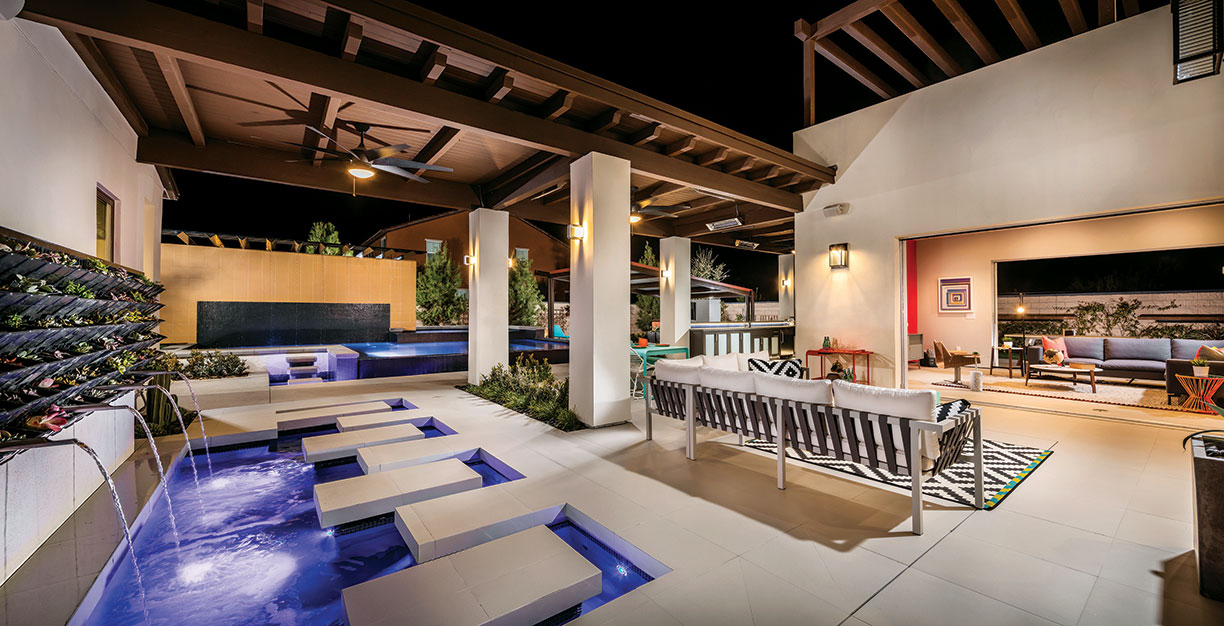
Millennials Are Change Agents
Expect to see millennials become luxury players. Right now, their impact on high-end markets is minimal, but this demographic is already a force shaping future home designs, particularly regarding energy efficiency and sustainability. “This is the homebuyer of the future and builders should be constructing homes to meet their desires,” says Lee Ann Head, vice president of research for the Shelton Group. “According to our Energy Pulse studies, millennials want more energy-efficient homes and the technology to easily monitor and control their energy consumption. Millennials are also more discerning about certifications and prefer certified energy-efficient homes.” Also, they are “very aspirational about solar energy and are adopting solar panels at a much higher rate than the overall population.”
Approximately 35 percent of U.S. homebuyers are millennials, and 67 percent of them are first-time buyers. But having delayed a first-home purchase, many millennials do not fit into the typical first-time-buyer profile. “It’s important to note that the first-time homebuyer is not what it used to be. Many of these folks are better established in their careers and many are more upscale. Therefore, many of them are in the market for their ‘dream home’ not their ‘starter home.’ Therefore, the list of features I’ve noted, which could drive a home price up, is not necessarily out of the question for these buyers,” explains Head. And, she adds, the greener homebuyer tends to be a better-educated, somewhat more upscale buyer.
Still Debating Whether Size Matters
If there was any given in the world of upscale real estate, it was bigger is better. Today, any consideration of home sizes opens the door to an entirely new dialogue based on diverse and changing consumer attitudes. For trophy homes, there is still nothing modest about square footage; uber properties are getting larger with increasingly lavish amenities. But designers, Realtors and architects also say clients want smaller homes and plans that engage every square foot. “People want to use their whole house. Fewer and fewer people are willing to have spaces just for formal occasions,” shares Elyssa Morgante with Morgante Wilson Architects in Evanston, Illinois.
Even the tiny house trend has found a luxury expression with what Florida developer Frank McKinney is calling a Micro Mansion. With just under 3,000 square feet under roof, McKinney’s tiny home is hardly micro, but it is still smaller than some luxury master suites. The inspiration he says came from Miami condos and also clients desiring a single-family residence in South Florida, but not another large estate they might only use a few weeks a year. Still, they expect a level of quality and finishes worthy of a mansion. McKinney has not compromised on finishes, design or drama in this ultra-luxurious home that includes unique features such as counters made of sea glass.
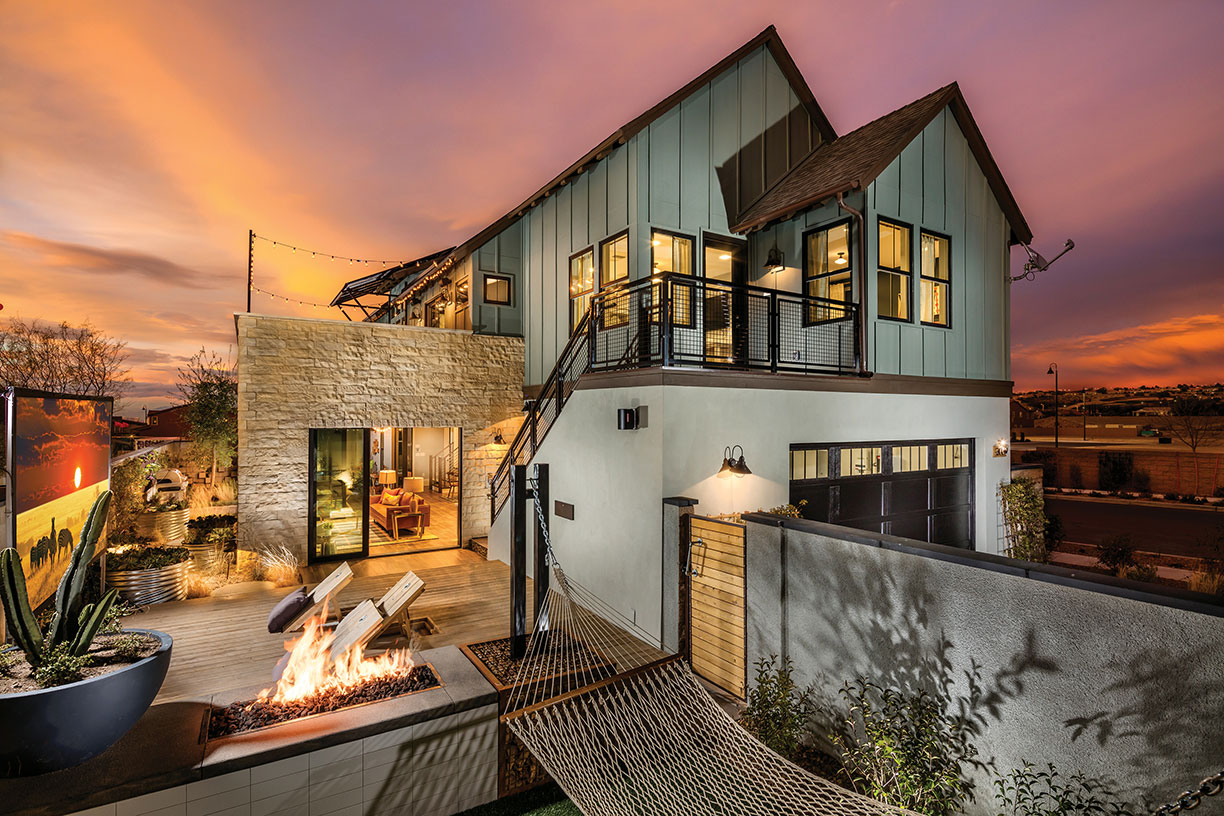
Photo courtesy Chris Mayer Photography and Bassenian Lagoni Architects
Functionality & Finishes
“It’s more about really functional spaces and higher-quality finishes,” says Chicago designer Donna Mondi. “Some people don’t want a living room. Instead, they’d rather have the space be a home office or a really beautiful study or library. A lot of it is more the function of the space than less space,” she explains. Like many designers, Mondi says consumers are becoming more discerning. “There is an appreciation for how a great faucet feels in their hands or a great doorknob feels versus a cheap one.”
Getting Smarter
Interactive design has completely altered the way we engage with our homes. “It has been a real cultural change that’s permeated through all product design. People are more demanding and more aware of the ease of use of interactive design because of their experience with smart phones,” says Marc Hottenroth, director of Industrial Design at GE Appliances. “We are starting to see the trend moving from tap and select on the phone to gestures and voice and then having a conversation with the product via a digital assistant.”
The addition of artificial intelligence takes interactivity to a new level. Already, it is boosting the IQ of smart homes by enabling protocols such as geofencing in which a predetermined series of actions (security disabled, lights turning on, music playing) are triggered when an owner (and their smart phone or watch) reaches a preset distance from home. Looking ahead, Hottenroth speculates on scenarios in which we might purchase say a rack of ribs at a grocery store and artificial intelligence would call up recipes and transmit them to a kitchen appliance. “There are all sorts of interactions that could take place that we never even thought about,” he says.
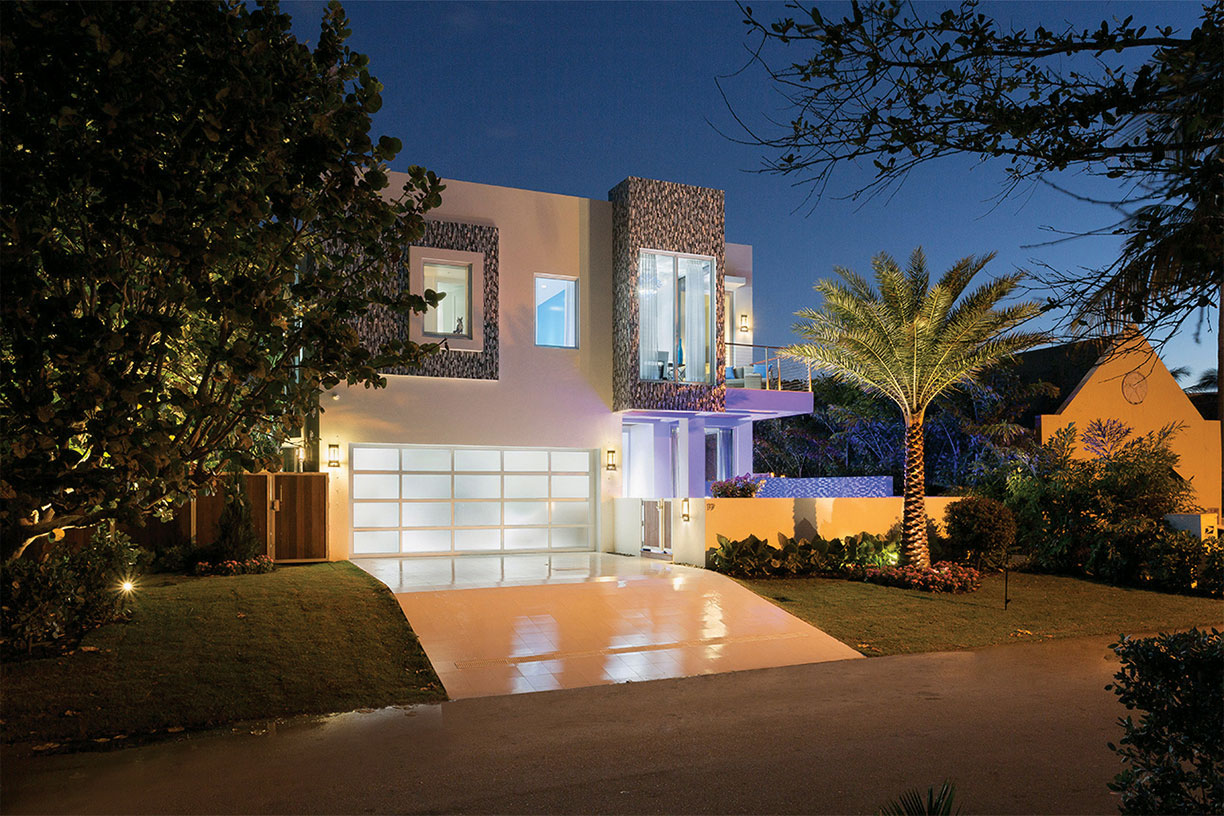
Photos courtesy Ed Butera, IBI Designs and Frank Mckinney
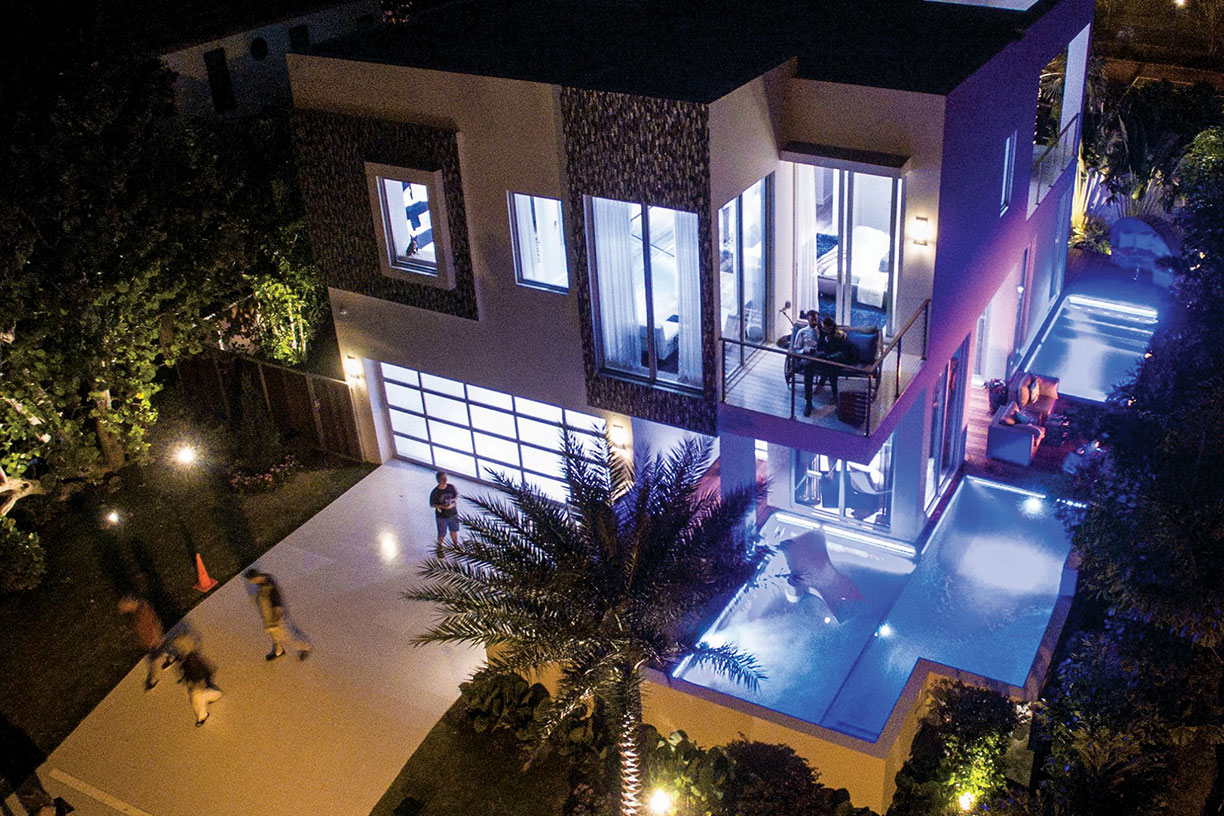
Can You Hear Me Now?
“We are moving toward rich interaction and the next wave is having no interface,” Hottenroth explains. Instead of using manual or digital controls to operate an oven, washer or other appliance, we will simply talk to them. Currently, GE has a digital assistant, Geneva, which meshes with Alexa or Google Home and enables consumers to control a number of appliances using voice commands. They can add minutes to a wash cycle, extend time in the oven or turn on the dishwasher from their bedside. They can ask if their laundry is clean or how much time is left on a cycle. Or Geneva — with a little help from her digital friends — can keep clothes tumbling in the drier a little longer. Unfortunately, folding clothes is not an option. Yet.
Wellness
Wellness as a concept for homes has been around for a few years, and most of the emphasis has been on construction materials and air quality. Now consumers and builders are turning attention to other aspects of wellness and materials that compromise air quality. The WELL certification for homes has been available for a few years, and new nonprofit advocacy groups such as Wellness Within Your Walls and the Sustainable Furnishings Council bring attention to furnishings and other products brought into the home. Expect to see more certifications for homes such as Indoor airPLUS.
More Than Cooking
Steam ovens, introduced a few years ago, tapped into new consumer preferences for healthier food prep. Following that trend, several new products take wellness and kitchens in a new direction, which expands on the idea that a kitchen can be a place to grow as well as prepare food, a concept often spied in one version or another of kitchens of the future. “Maybe it’s just California being healthy eaters, I say we’ve definitely seen steam ovens as well as composting as a trend. We integrate a lot of composting. Not only do you have your garbage and your recycling, but you also have your compost. That’s involved in every kitchen now,” says San Francisco designer Kriste Michelini.
At this year’s Consumer Electronics Show, a new appliance from WLabs of Whirlpool Corporation, the Zera Food Recycler, took home awards in several categories including Eco-Design and Sustainable Technologies. Using an automated process, Zera can break down a week’s worth of food waste from the average family into ready-to-use homemade fertilizer in 24 hours. All it takes is a push of the button or the Whirlpool mobile app.
The Urban Cultivator, a residential version of a commercial product, brings the ability to grow herbs and greens into the kitchen. The product can be free standing or installed to blend with existing cabinetry and looks very much like an undercounted wine refrigerator. It includes automatic air circulation, watering and custom formulated organic plant food. Growing potential include greens such as kale and arugula as well as herbs.
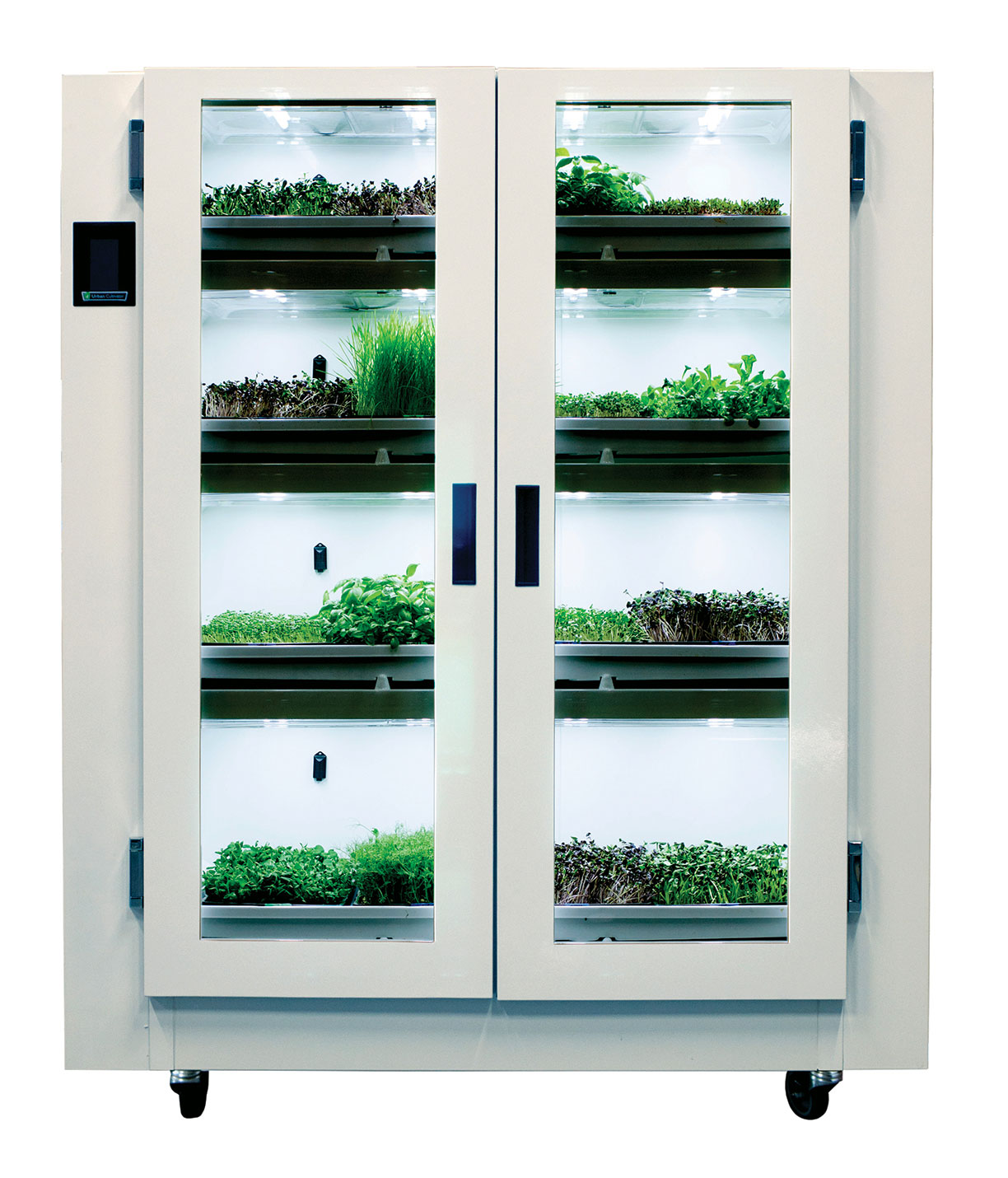
The Urban Cultivator
Photos courtesy the urban cultivator
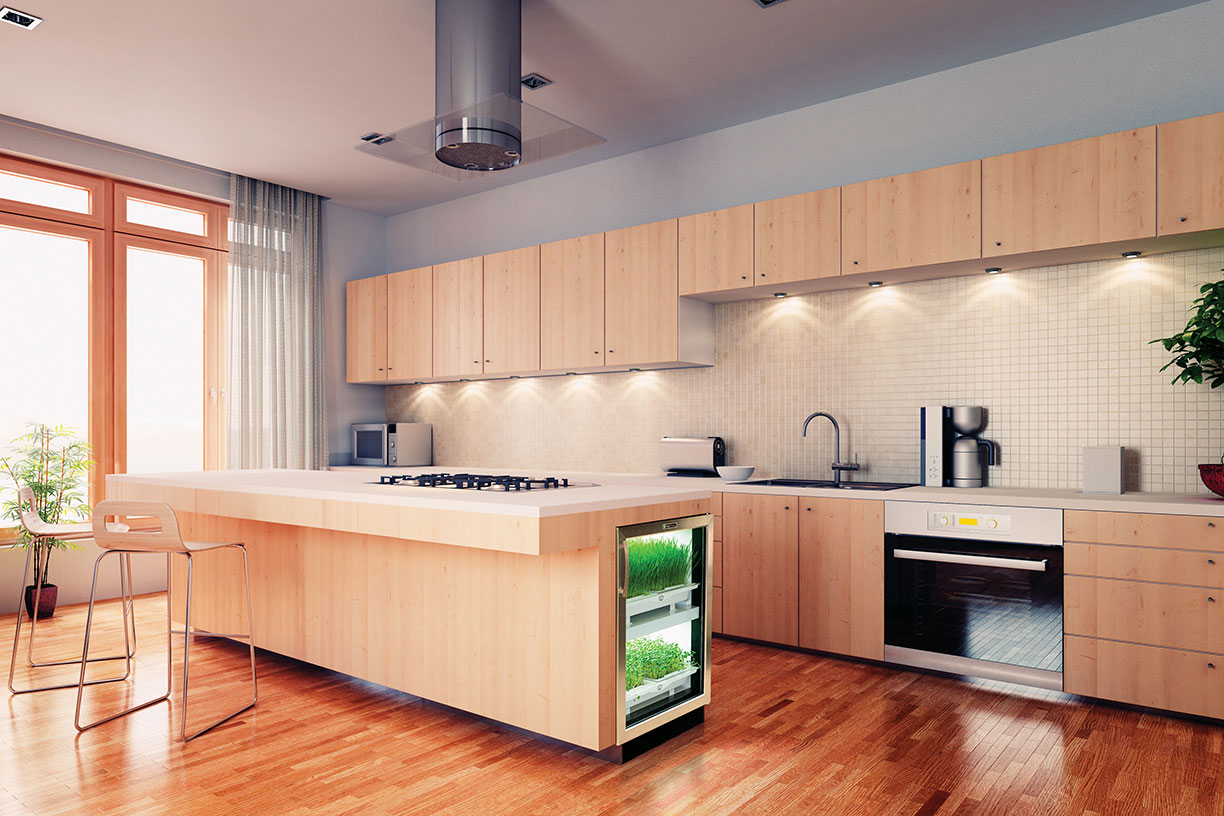
Flexibility & The Sharing Economy
Today, homeowners typically stay in their homes for an average of 8 to 10 years, so it’s no surprise flexibility has emerged as a desired attribute for homes. While most attention is focused on rooms that can be adapted in multiple ways, architects are focused on ways homes overall can adapt to the changing needs of homeowners. For the 2016 International Builders’ Show, Newport Beach architects Bassenian Lagoni (BL) designed two homes geared toward changing lifestyles. “We wanted a home that can morph and flex over time,” says architect Hans Anderle, who was on the BL design team. In both models, the entry-level Contemporary Farmhouse or move-up Contemporary Traditional, fluid floor plans enable rooms to be used in a number of ways and are enhanced with seamless indoor/outdoor connections on multiple sides of the homes. Additionally, both homes incorporate spaces giving families options to adapt the home to their own lifestyle. A first-floor suite with a mini-kitchen is suited for adult children, grandparents or visiting family. But an outside entry also makes it ideal for Airbnb guests or for a home office. Both homes include another separate space for rentals or guests or a home office. Not only do these designs accommodate changing spatial needs of a family, but the intent was also to include ways for entry-level owners to afford the home initially and then adapt it as their lifestyle changed.
Changing Architecture
Architecture is not static. Instead it’s always evolving. Right now, contemporary holds sway, but still it’s rooted in regional vernaculars, which syncs with the growing consumer desire for authenticity. Look for more transitional styles in new homes as well as existing homes as more owners opt to renovate rather than move. Even hard-edge contemporary styles are softening in some regions.
Traffic
Traffic and gridlock aren’t often mentioned as change agents, particularly for homes. However, in some cities, both — along with access to alternate transportation — play a role in home values, pumping up prices and demand. Self-driving cars are often cited as a potential solution, but even urban planners don’t have a solid take on the impact on cities, let alone housing. Some believe autonomous transportation will create more demand for suburban locations.
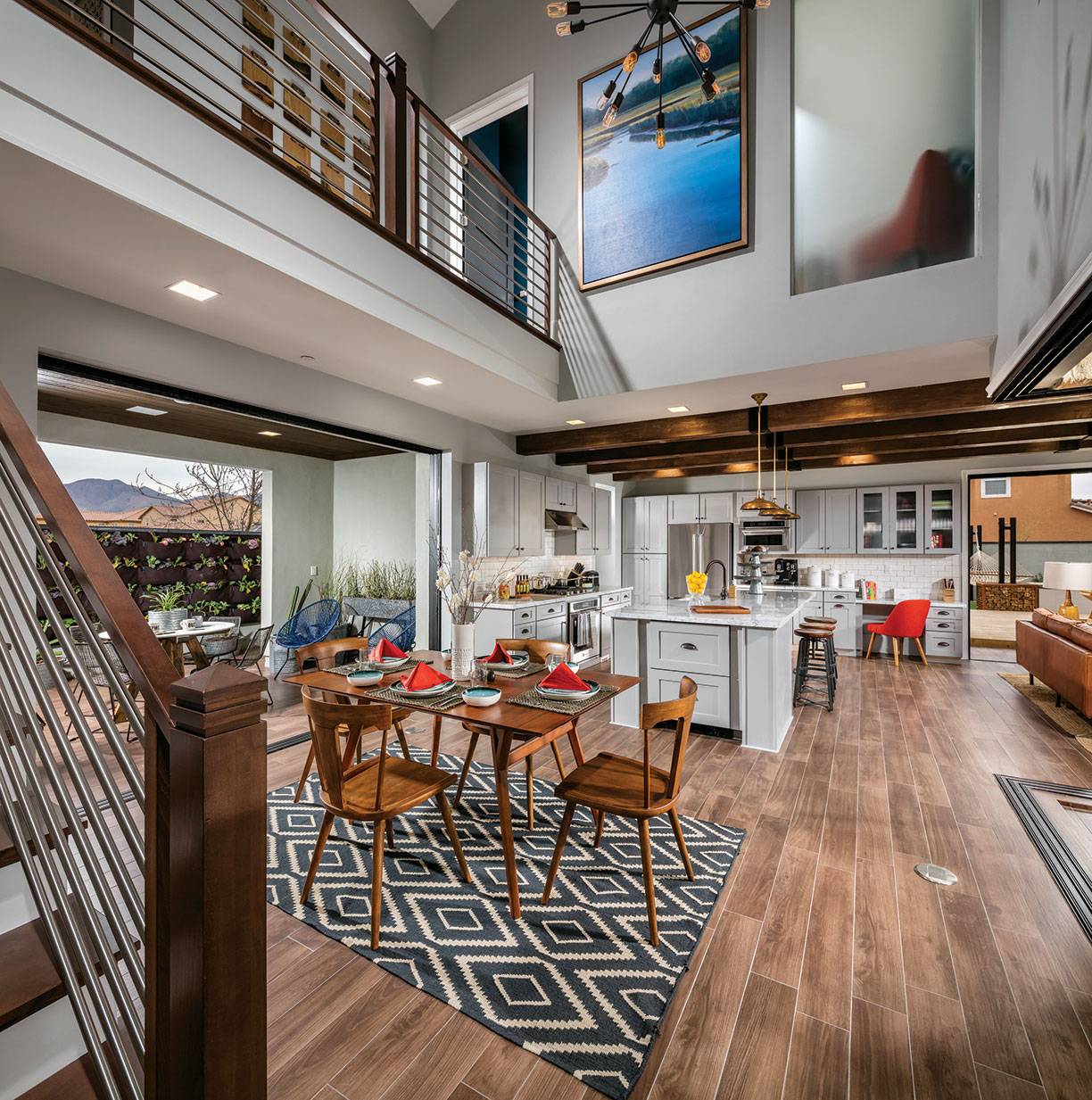
The recipe for a home of the future: indoor/outdoor merger, authentic materials, and dramatic design.
Photo courtesy Chris Mayer Photography and Bassenian Lagoni Architects
As summer approaches and the peso hits an all-time low, travelers are thinking of new ways to stretch the American dollar and reach new-found forms of luxury. With this in mind, we’ve comprised details on four top-tier resorts and residences that offer not only a beachfront oasis, but truly showcase how people are exporting their lifestyles internationally from the Edible Gardens of Cabo to the Lock-and-Leave residences of Playa Mujeres.
Below is more information including brief property descriptions, their incredible list of amenities and what comes with a $1 million price tag.
Cabo’s All Inclusive Eco-Friendly Escape: 1 Hotel & Homes Cabo
1 Hotel & Homes Cabo is a limited offering of 55 for-sale branded luxury “1 Homes.” The first international residences from mission-driven brand 1 Hotel, 1 Hotel & Homes Cabo is already 50% pre-sold, with completion slated for 2018.
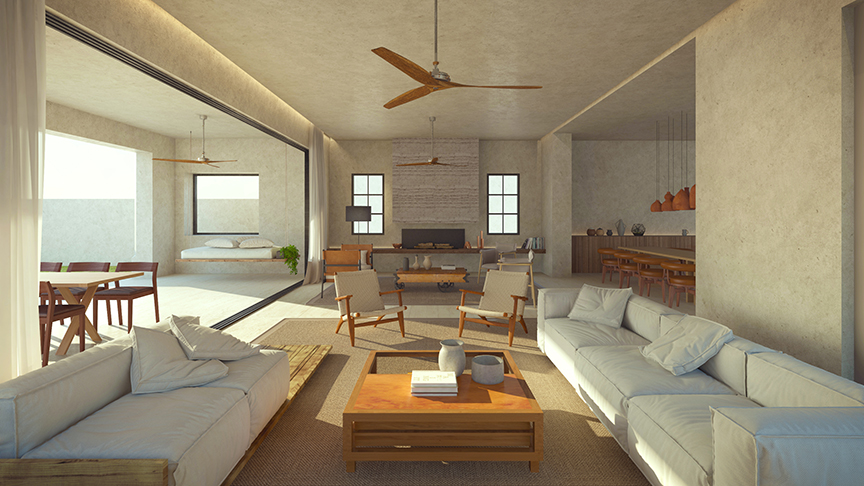
Floorplans: One to seven bedrooms, including a collection of beach-front villas.
Location: Cabo San Lucas, Mexico – in the heart of the city within an oasis of its’ own.
Highlights:
- A 115-room environmentally-responsible hotel
- Four swimming pools
- 24-hour concierge
- Seed Spa
- Eco-conscious
- Dinning/cooking school concept El Mercado
Pricing: $600,000’s – $7,000,000
Paradise on Untouched Locale, Playa Mujeres: La Amada Residences
La Amada is a private new collection of 215 fully completed spectacular residences, located within Playa Mujeres, a private community with its own Marina and a spectacular Greg Norman designed golf course.
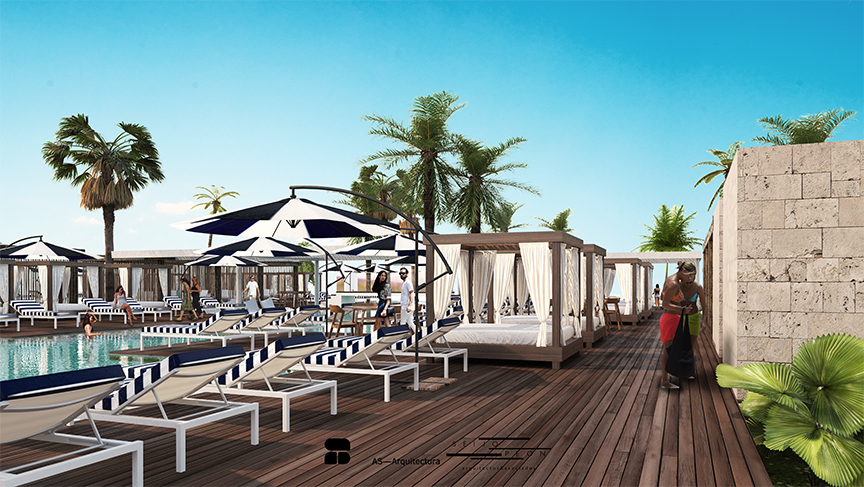
Floorplans: One, two and three-bedroom condominium homes are also available featuring gourmet kitchen with ocean, marina, or lagoon views.
Location: As the only residential offering in Playa Mujeres, La Amada is just a 15 minute drive from Cancun.
Highlights:
- Full suite of concierge services and amenities.
- Brand new beach club,
- Roof-top pools
- State-of-the-art gym and a marketplace café
Pricing: $300,000’s – over $1.3 million
The Spirit of Seaside Living: Playa de la Paz
Playa de La Paz offers a collection of 23 residences that boast extraordinary, unobstructed ocean views and 600 feet of ocean frontage, endless privacy and sophisticated communal spaces to enjoy the surrounding nature.
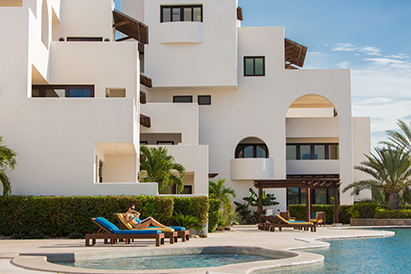
Floorplans: One to four bedroom residence, starting at 2,900 square feet.
Location: La Paz, Baja California, Mexico – perfectly positioned along the clear waters of the Sea of Cortez.
Highlights:
- Oceanfront pool, fitness facility and an outdoor yoga studio
- Stand up paddle boarding, kayaking and snorkeling
- Concierge services that can arrange off-property activities in addition to events on-site including beach barbecues and weddings
Pricing: Starting at $1 million
Living the Luxury Resort Lifestyle: Punta Mita
DINE, in conjunction with JLL (Jones Lang LaSalle), have just launched the spectacular new condominium collection. Las Marietas condominiums are an exclusive enclave of 42 residences adjacent to the 18th hole of the Jack Nicklaus Signature Bahia Golf Course.
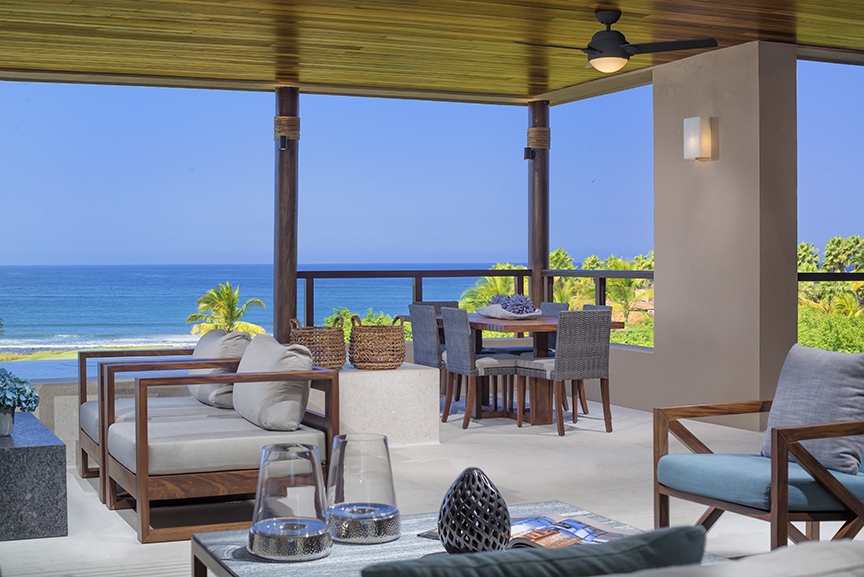
Floorplans: 3 bedroom or a 4 bedroom
Location: Nestled on a 1,500-acre private peninsula on the southwest point of Mexico’s Riviera Nayarit region.
Highlights:
- Starchitect: award-winning architectural firm of HKS Hill Glazier
- Elevator access, underground parking, owner storage units
- Swimming pools, fitness center and an open-air barbecue area
Pricing: $400,000- $5 million


